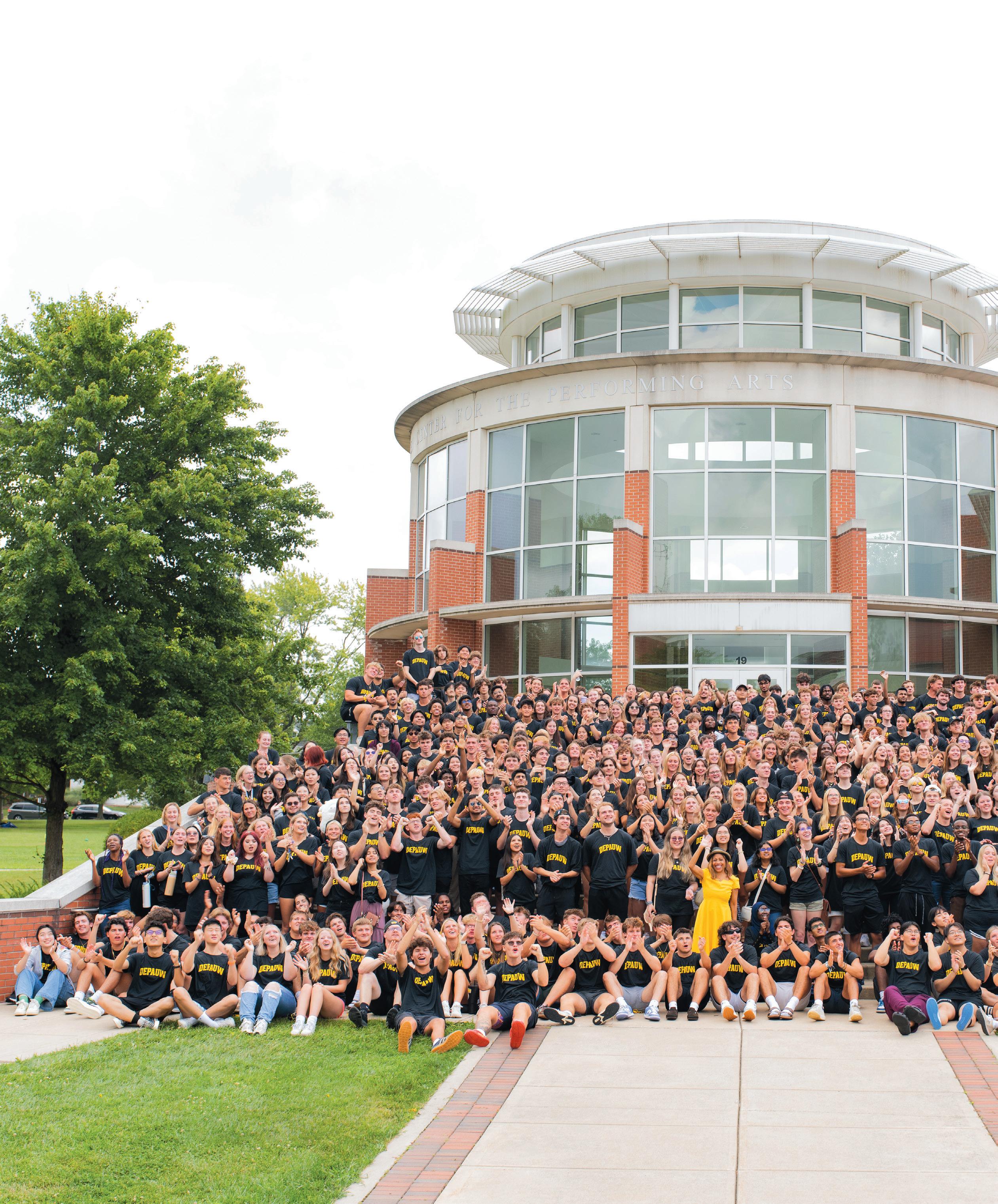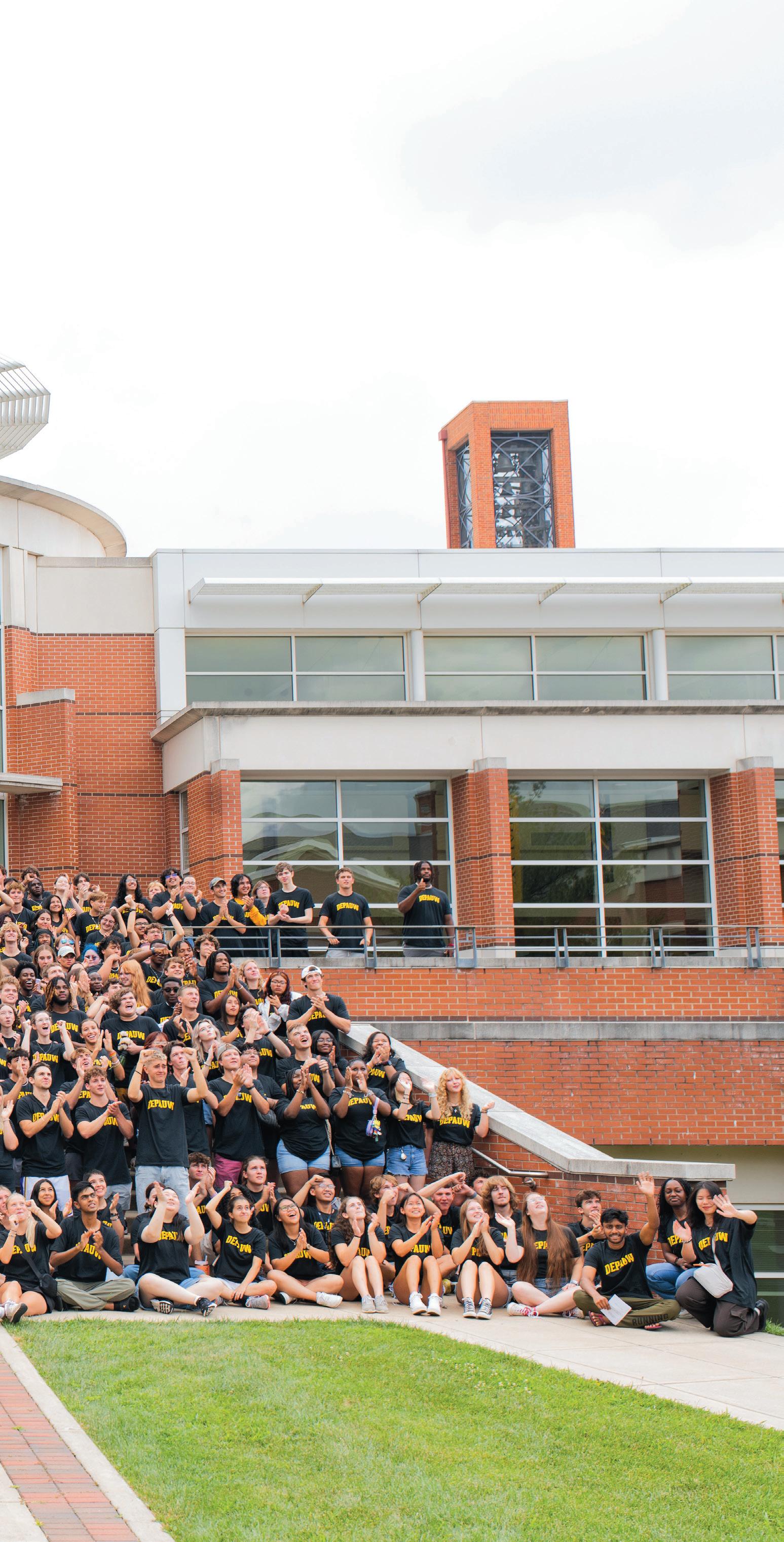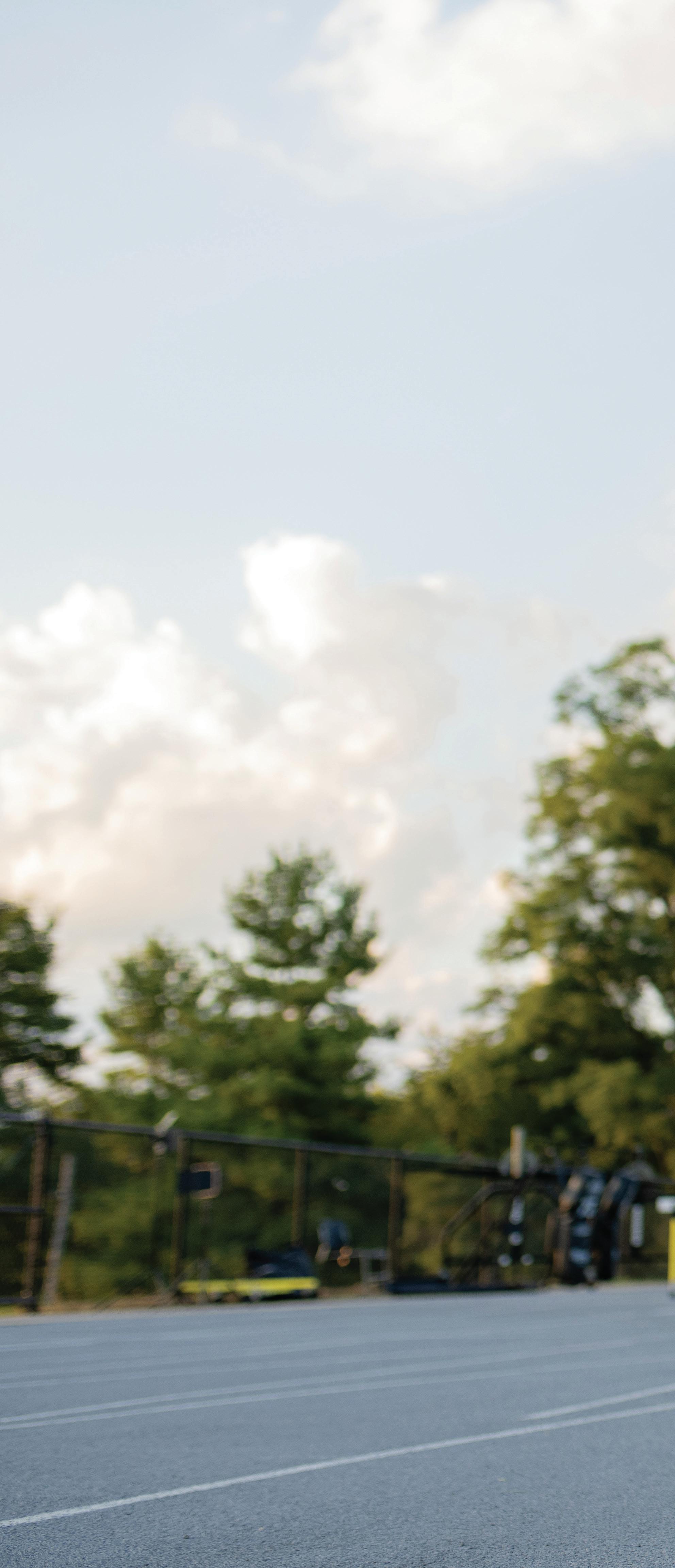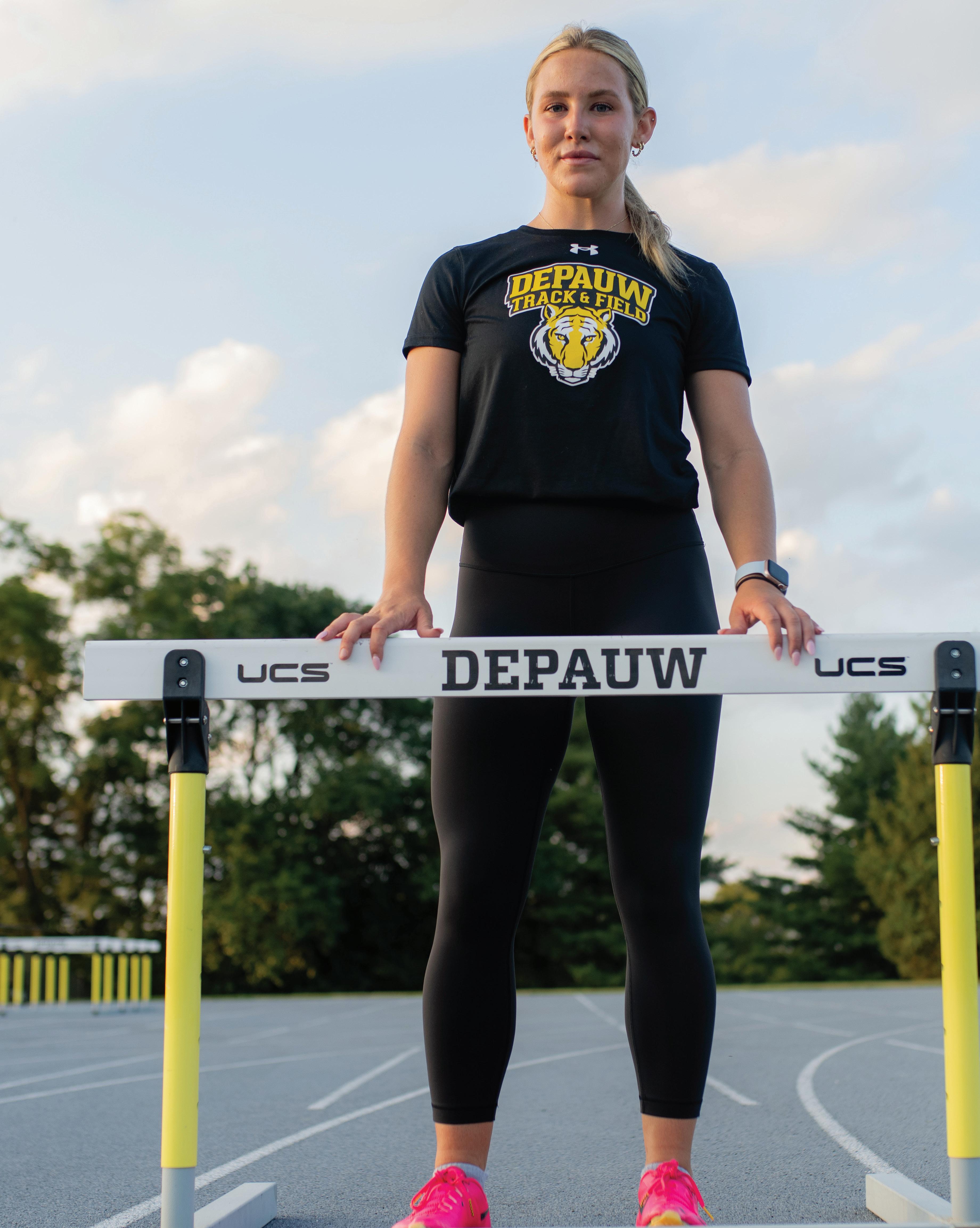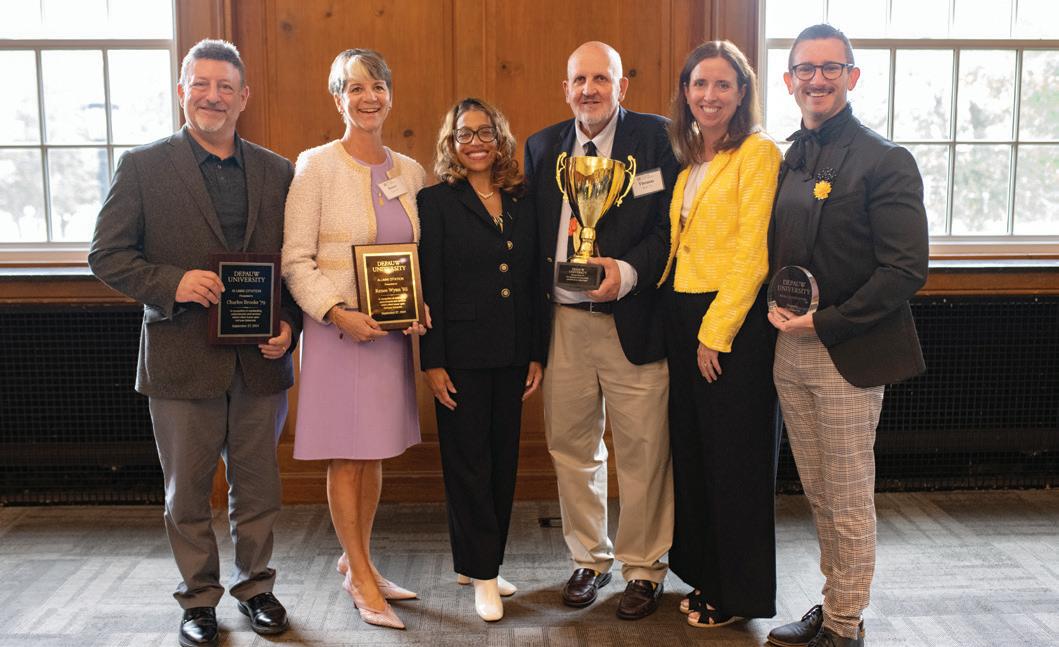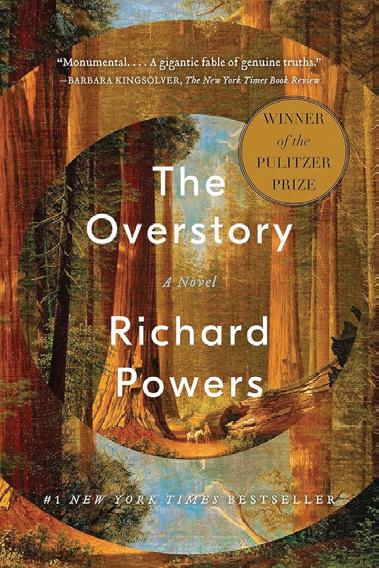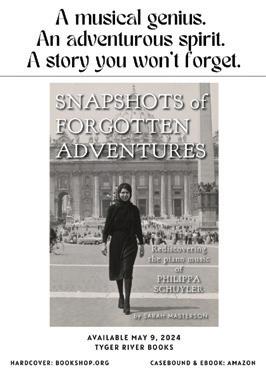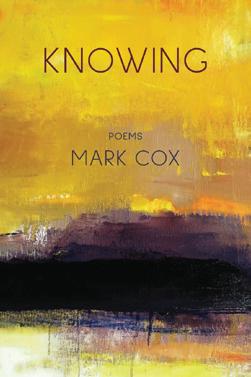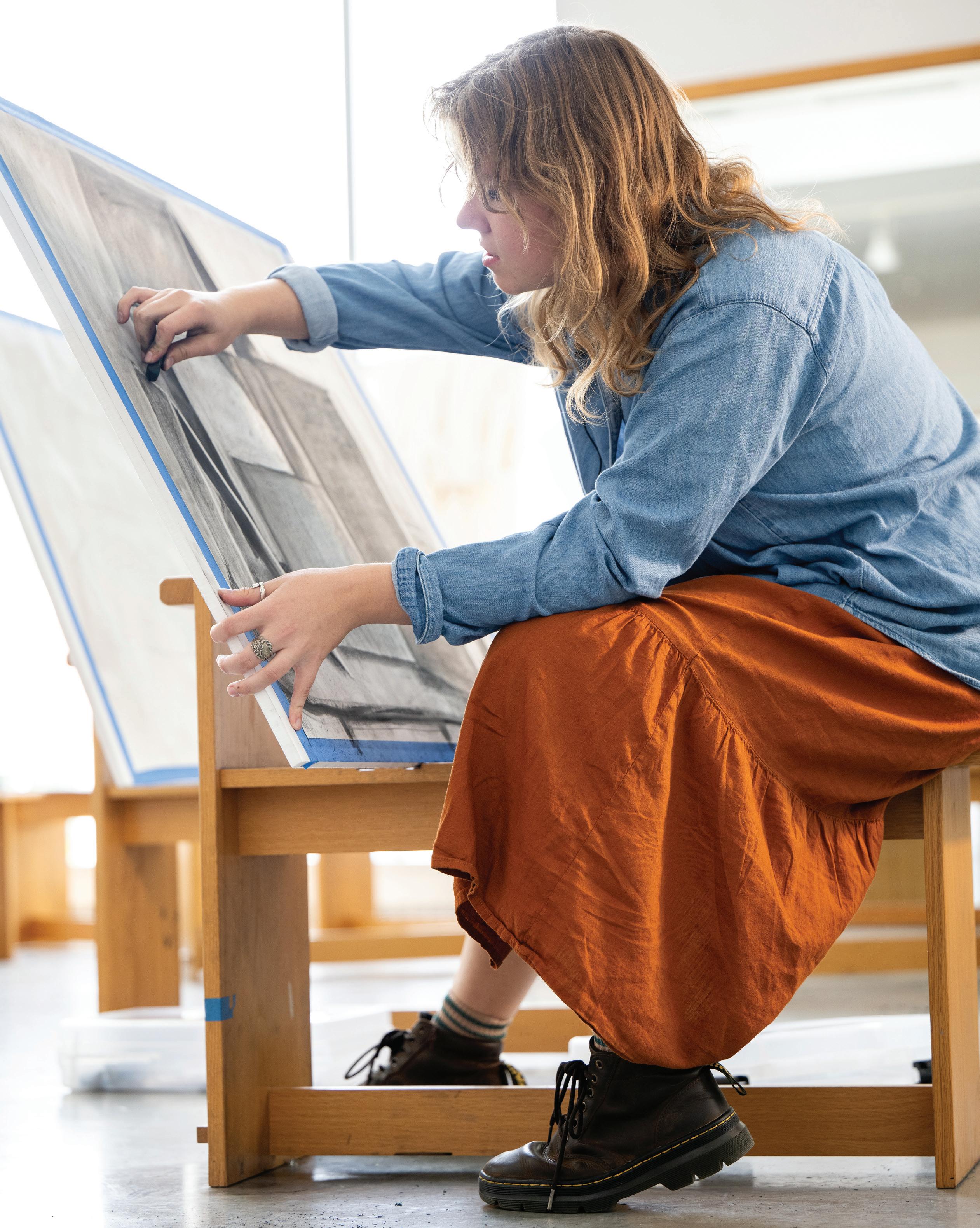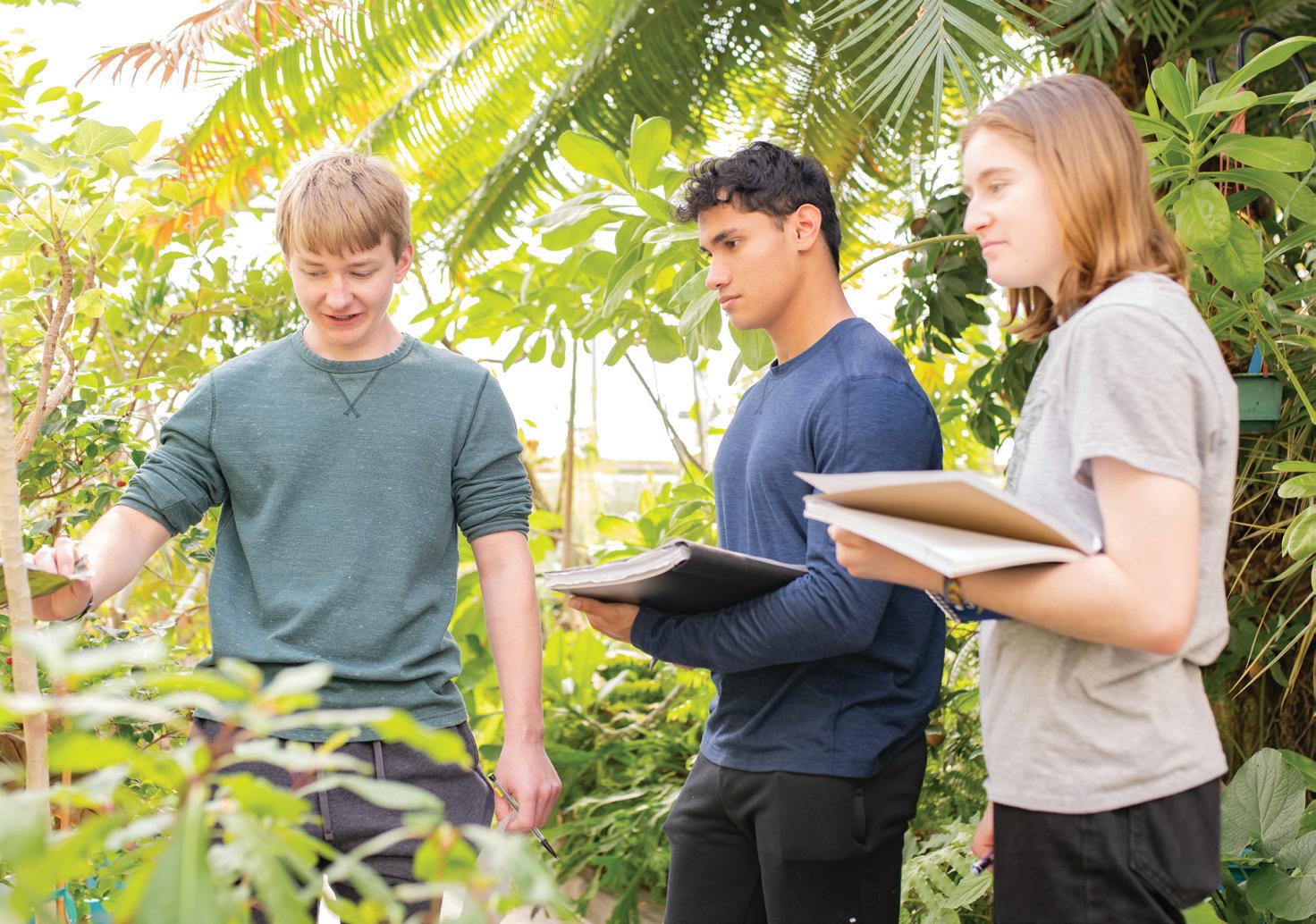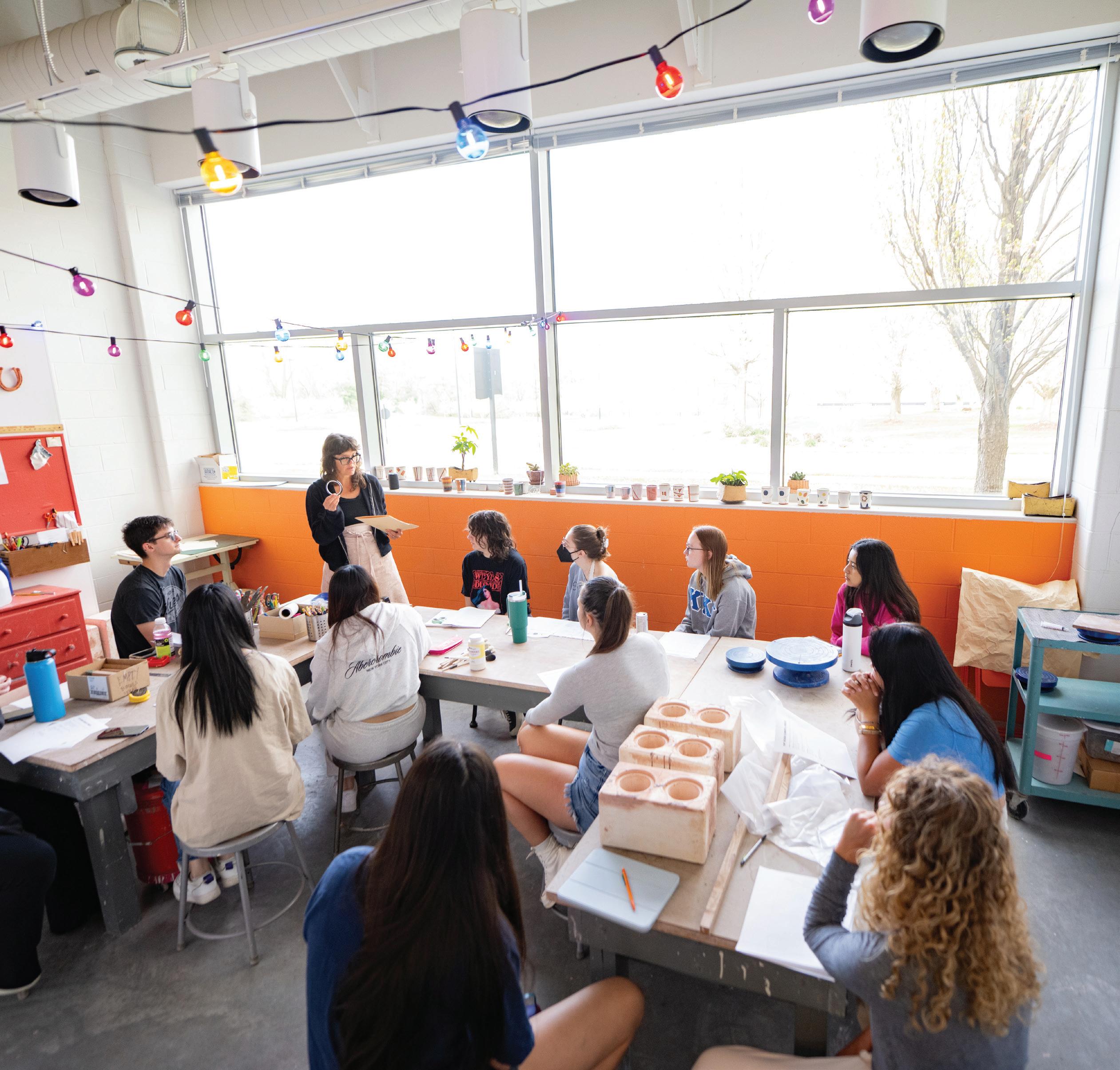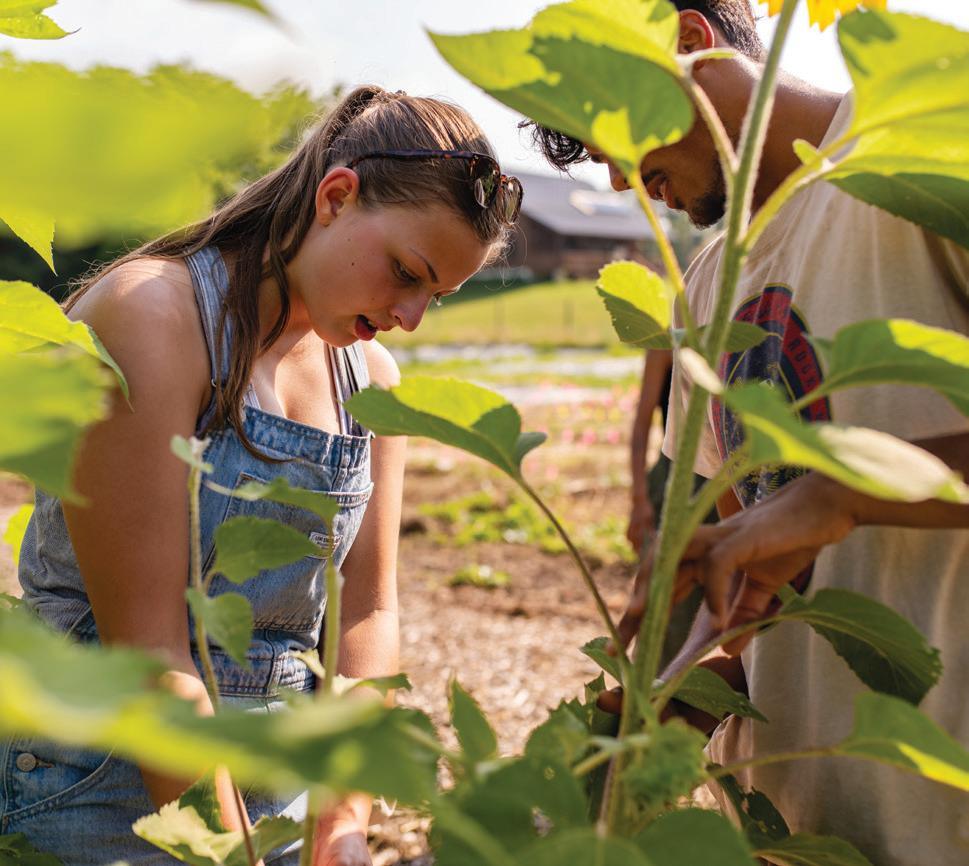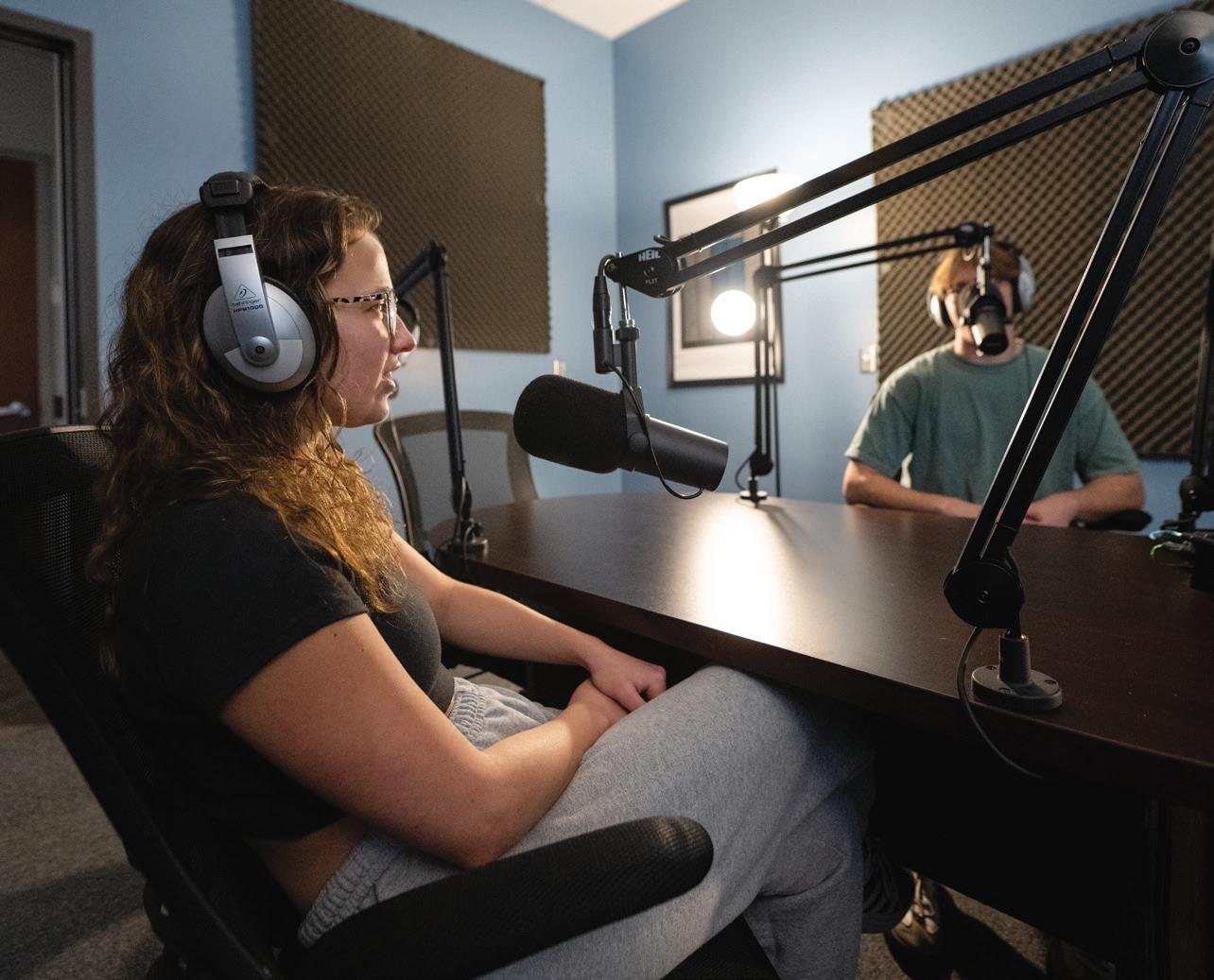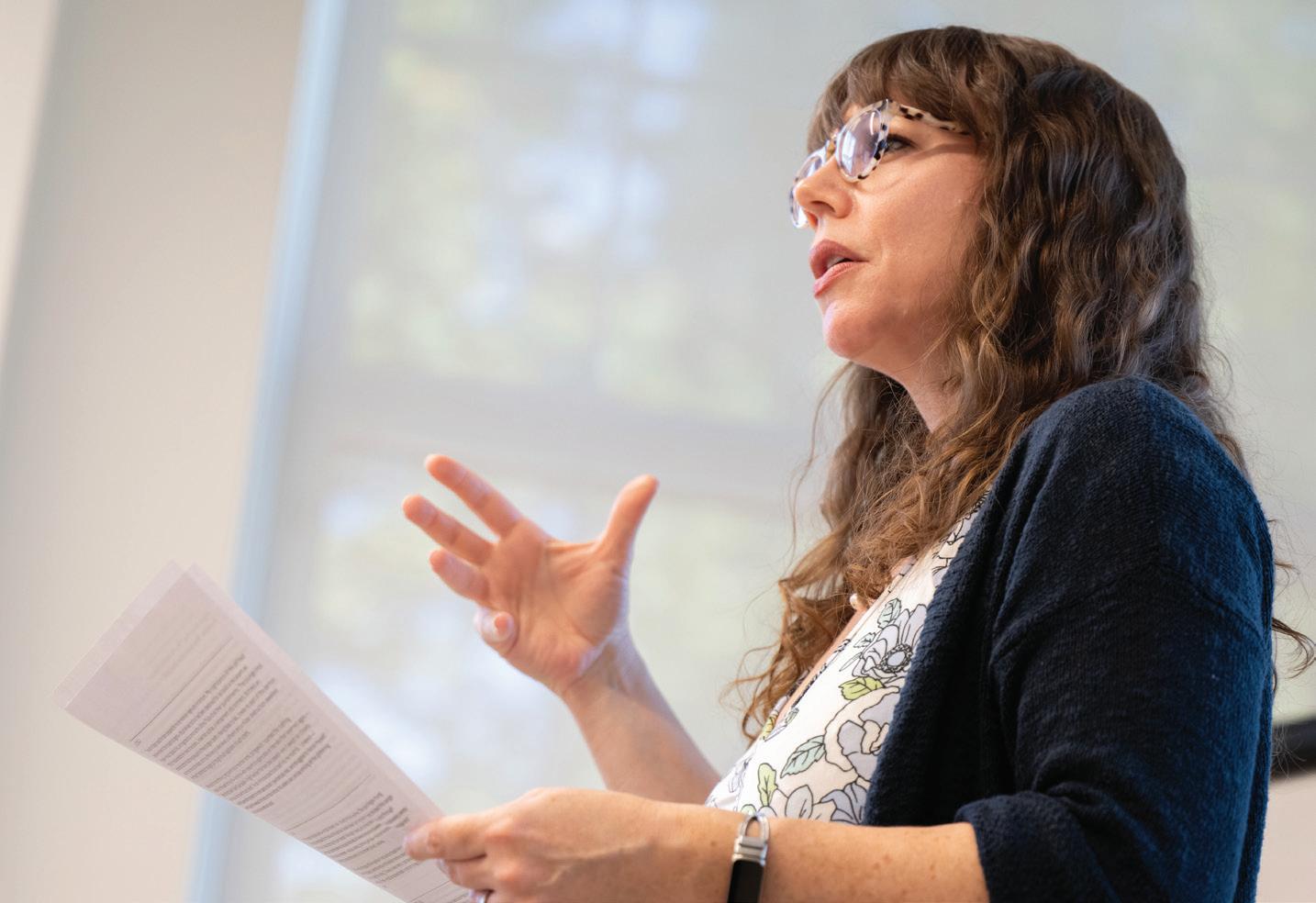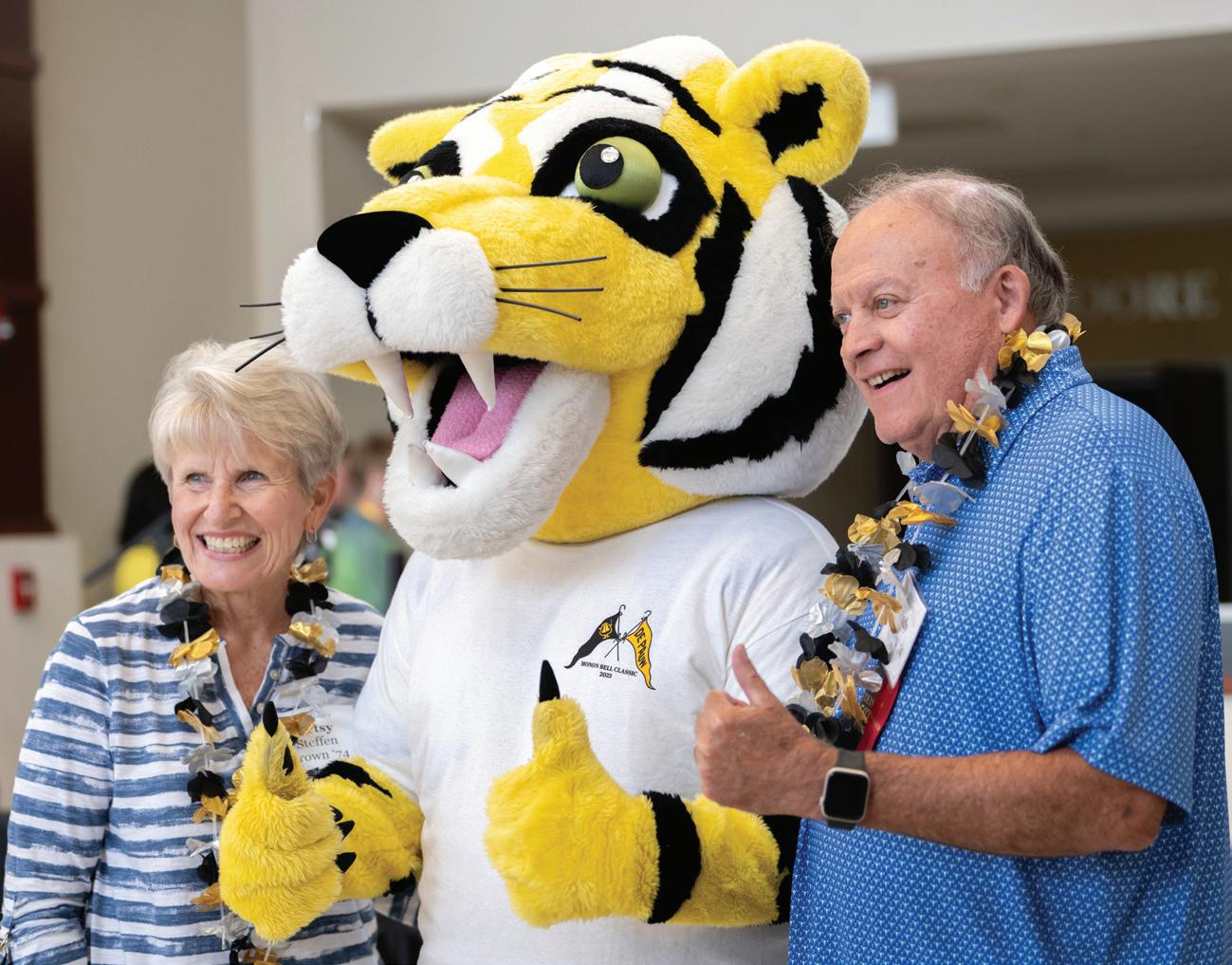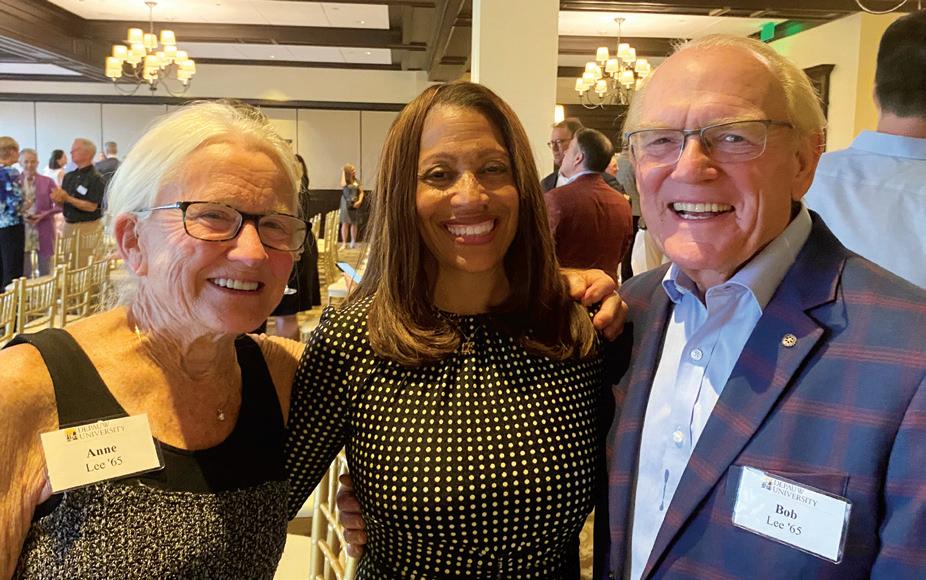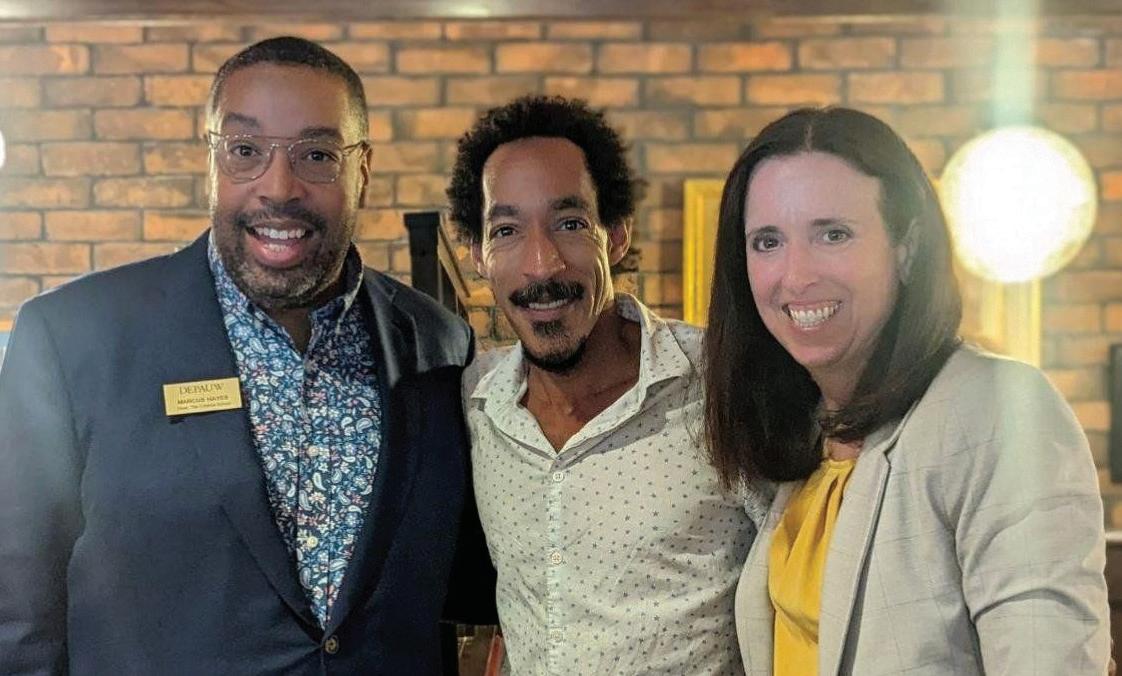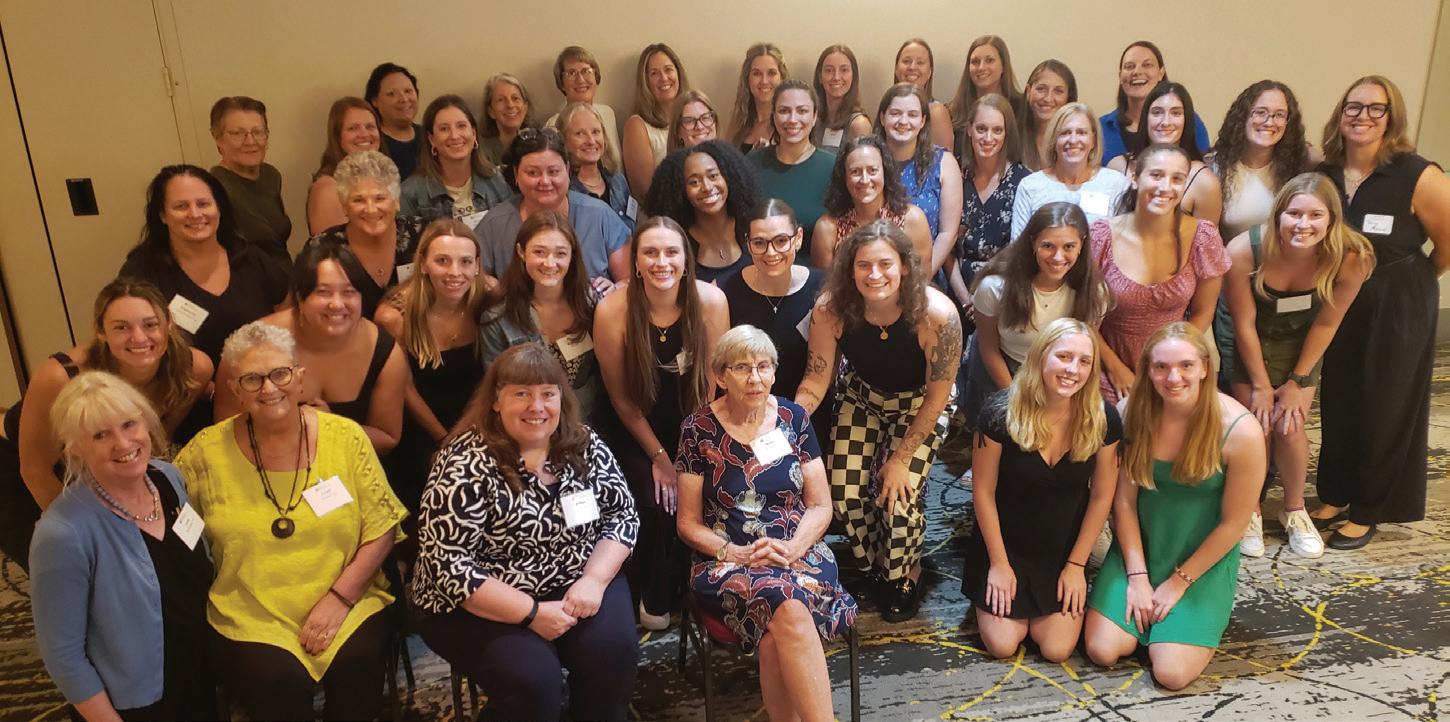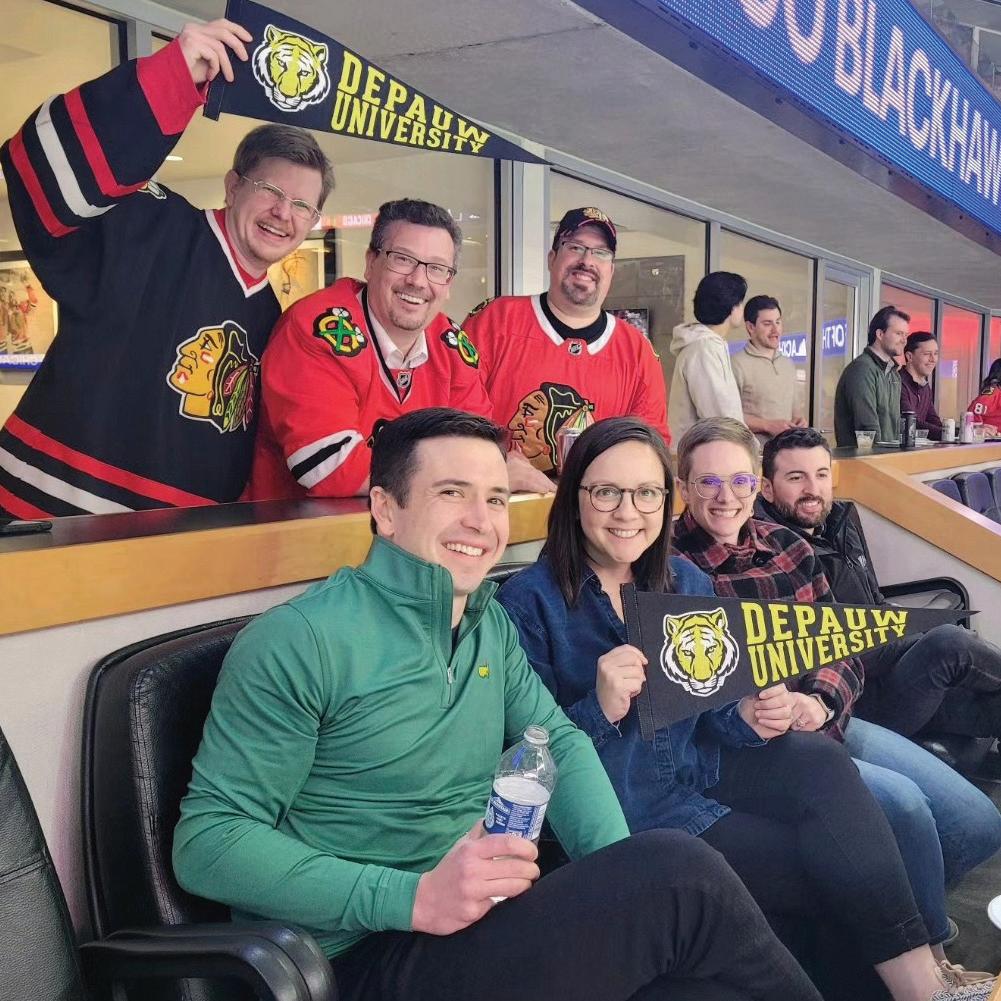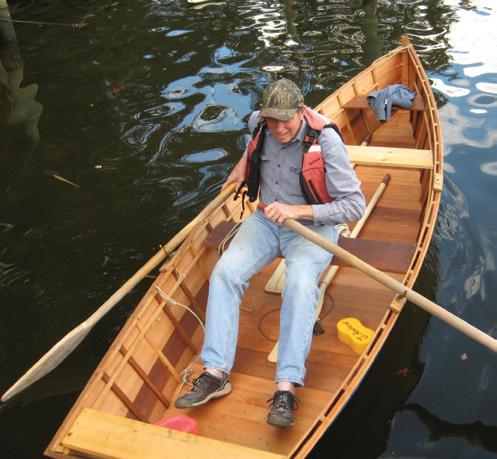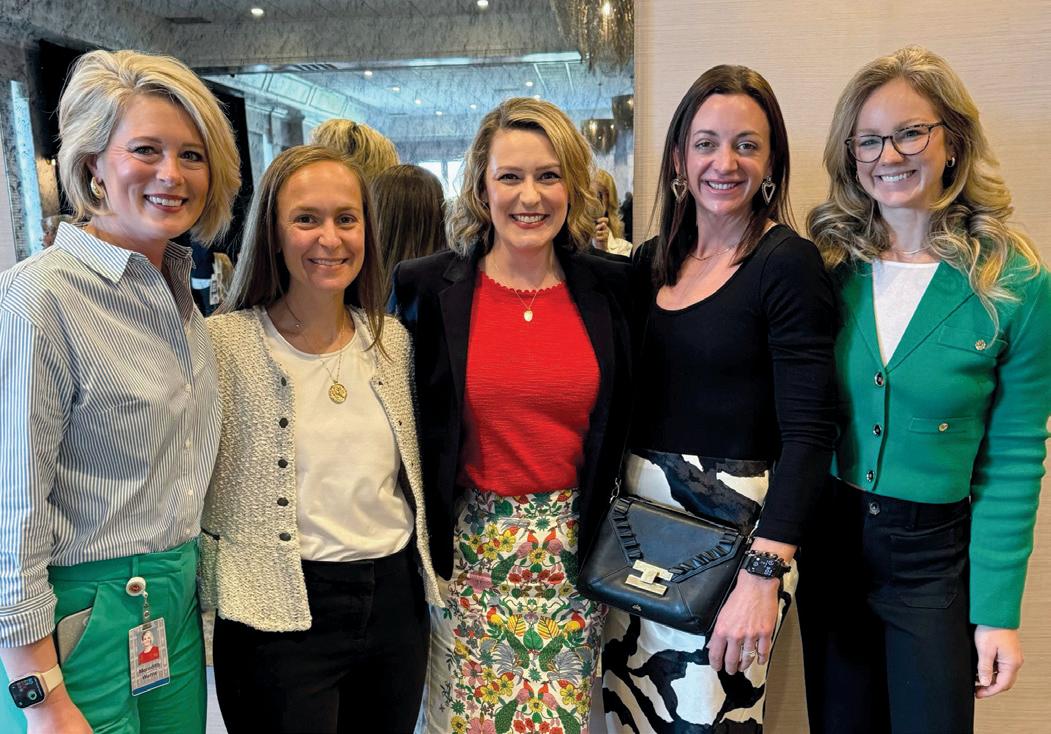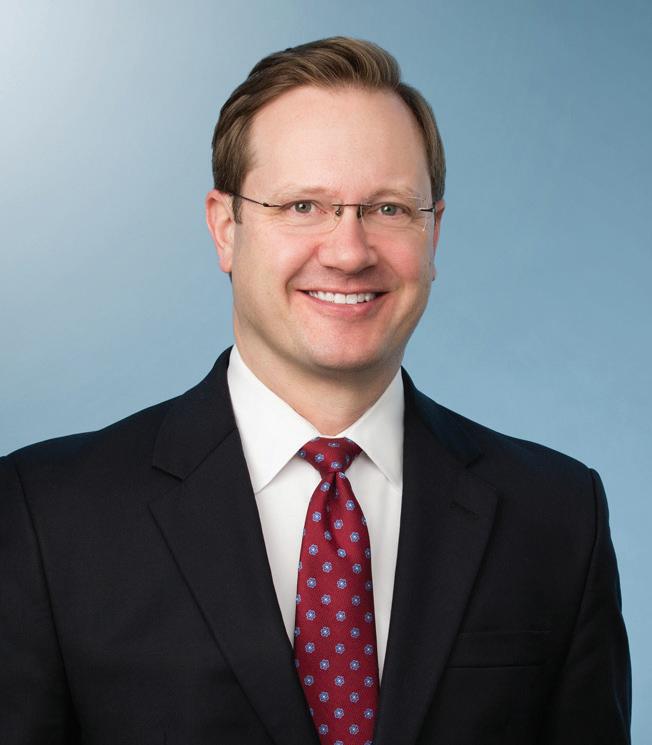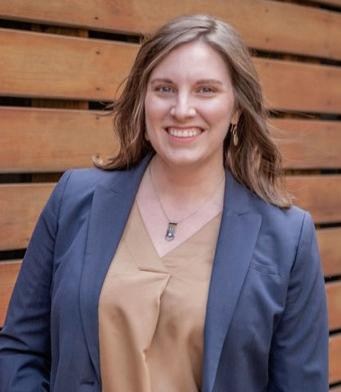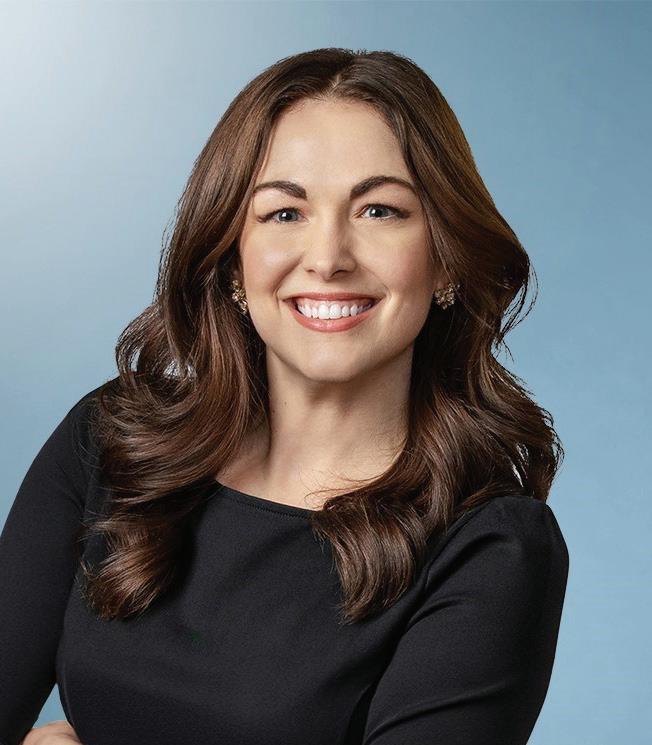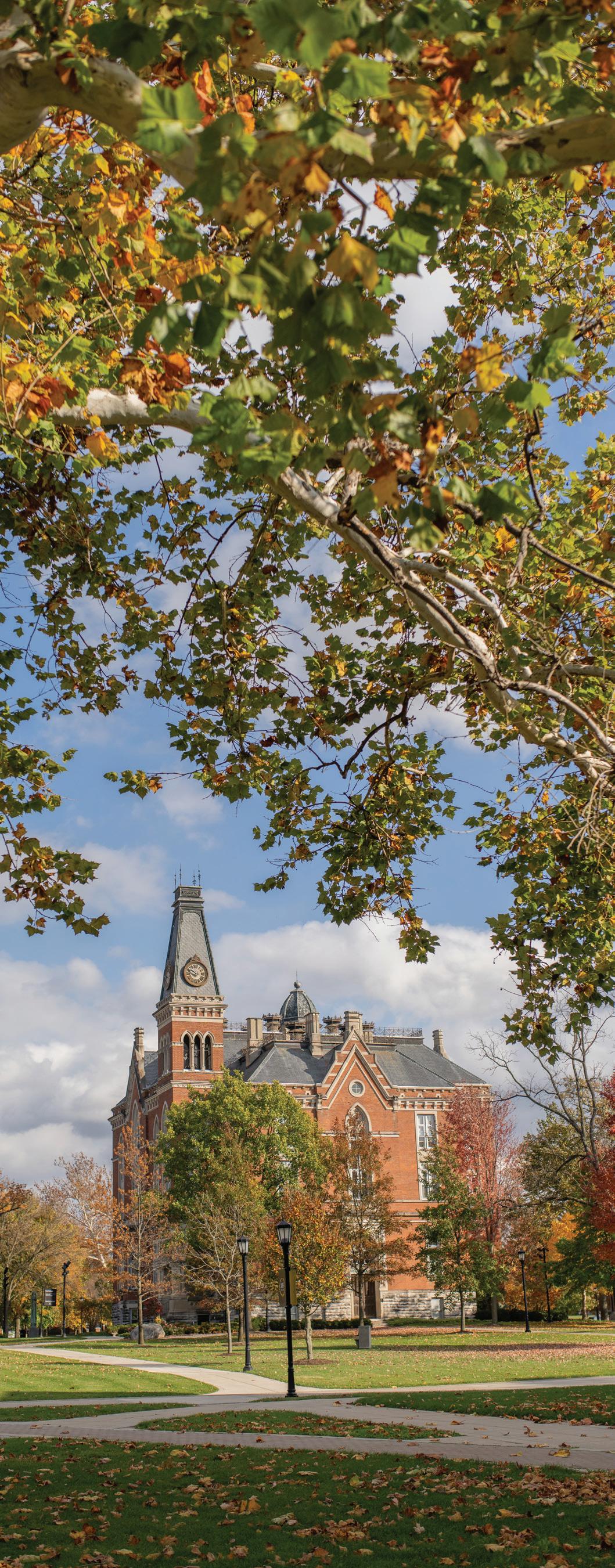Gatherings
DePauw alumni gathered in Greencastle and locations nationwide to reunite, celebrate great memories, learn about DePauw’s bright future and, most recently, to welcome in the newest members of the DePauw family. Stay in touch by making plans to visit campus or one of our regional events.
President Lori S. White spoke to alumni about the three-school model in Skokie, Illinois, on June 12, 2024, with Marcus Hayes, dean of the Creative School; Bridget Gourley, dean of the College of Liberal Arts and Sciences; and John Clarke, dean of the School of Business and Leadership. The event was hosted by Kenneth Coquillette ’82 and Carrie Melind Coquillette ’82, and Marshall Reavis ’84 and Amy Zino Reavis.
Pictured with Dr. Lori S. White (center), Bob Lee ’65 and Anne Self Lee ’65 celebrated their 59th wedding anniversary.
Marcus Hayes (left), dean of the Creative School, Josh Thompson ’04 and Amy Kwas ’93, vice president for development and alumni engagement, at Indy lunch event.
DePauw welcomed 65 legacy students in the Class of 2028.
DePauw Alumni
Signature Events 2024-2025
November 2024
#OneTeamDePauw Giving Campaign
November 8-10, 2024 Coming Together
November 16, 2024 Monon Bell Game
May 17, 2025
Welcome to the Alumni Association, Class of 2025!
June 5-8, 2025 Alumni Reunion Weekend
Scan the QR code for a full listing of upcoming events.
Brian Zalewski ’93, far right, is the new president of the Greek Community Board. Brian is pictured with (from left to right) Brad Simmons ’93; Jennifer Pelzer Martay ’93; Amy Kwas ’93, vice president for development and alumni engagement, and Jean Throckmorton Puyear ’93;
Alumni Board at a Blackhawks game. Photo courtesy of the Tenzer family.
In September, Women’s Swimming and Diving celebrated 50 years at DePauw.
Attending Old Gold to cheer on #21, Jake Comer ‘25, were Beth Montgomery Selke ’69, Brenda Montgomery Tewel ’65, Sam Comer [Wabash ’24] (“We still love him”), Ben Comer ‘93 and Meg Comer ’93. Back: Ken Tewel and Lee and Mary Lee Comer.
Class Notes publishes submitted updates about DePauw alumni’s careers, milestones, activities and whereabouts. Send your news to DePauw Magazine, P.O. Box 37, Greencastle, IN 461350037. Prefer digital? Fill out a form at depauw.edu/ classnotes, scan the QR code or email classnotes@depauw.edu.
Space considerations limit our ability to publish photos. Group photos will be considered if you include each person’s name (first, maiden, last), graduation year, and information about the gathering. Digital photos must be high-quality JPEGs of at least 300 DPI. Submitted hard copies cannot be returned. Questions? Contact communicate@depauw.edu
Find more alumni news at www.depauw.edu/ alumni/alumni-e-news/or scan the QR code.
1962
George C. Thornton III is a member of a team of swimmers recently recognized by Guinness Records as the oldest team to swim across the English Channel. He was 81 years old at the time of the 2021 swim. Other team members included another man aged 81, a woman aged 72, and other swimmers aged 65 or older. While the event was in 2021, it took a couple of years to authenticate the ages as the oldest team.
1964
James L. Andrew finished building a 15-foot skiff. Nancy Andreae Andrew won a prize at the Maryland State Fair for a quilt she made. (See photo.)
Roger Nelson was awarded the Beckenbach Book Award from the Mathematical Association of American for his book, “Nuggets of Number Theory.” Nelson is a professor emeritus of mathematics at Lewis & Clark College.
Karen Sandberg Craig relocated to the Midwest after 35 years in Arizona. Their horse farm is located on 12 acres in Sikeston, Missouri.
1967
A group of ’67 ATOs have met annually in Greencastle every spring since 2017. (See photo.)
1968
Sigma Nus from the class of 1968 visited their old home in May. (See photo.)
1969
The brothers of Sigma Nu fraternity, class of 1969, got together for their 55th reunion in Las Vegas in May. A great time was had by all! (See photo.)
1972
Jay S. Frye was inducted into the Indiana Basketball Hall of Fame. He lives in Sarasota, Florida.
1967 Alpha Tau Omega brothers gather in Greencastle. Shown from left to right: Ron Miller, Tom Drew, John Marlatt ’69, Bill Parker, Dan Blaney, Joe Newlin, Jon Heine, Bill Bucher and Steve Martin.
1969 Sigma Nu brothers celebrating their 55th reunion in Las Vegas included (from left to right) John C. Campbell, Duane M. Kelley, Russ Zink, Stephen M. Murray, Bruce A. Buhrandt, Gregg A. Dobbin and Frank J. Cercone.
James L. Andrew ’64
1968 Sigma Nu brothers John J. “Germ” Germanotta, Thomas R. “Shorts” Arendshorst, Wayne G. “Stalk” Jeronimus and Stephen C. “Grubby” Grubbs.
1973
Thomas “Taj” Ainlay Jr. received the Sierra Club’s 2024 Volunteer Service Award, which honors volunteers for strong and consistent commitment to the environment or the Club over an extended period of time.
1974
Anthony N. Minstein is the president of Local 11637, Louisville Federation of Musicians. As president, he works with city leaders, state officials and fellow trade locals improving the work life of professional musicians throughout the Louisville metro. He recently started a nonprofit (along with fellow alum Jonathan C. Hardy ’74) dedicated to bringing live music to underserved communities throughout central Kentucky and southern Indiana. Their local membership has grown to over 370 musicians, primarily due to the many live performance engagements the federation sponsors with grant funding and services for musicians. He continues to perform jazz with his own trio and plays sax, clarinet, flute and oboe in Broadway shows in Louisville. He is in his 30th year teaching business and management at the University of California Berkeley.
1976
Mark Gadson ’76 released his latest single, Feel that Love Again. Mark credits his professors, fellow students and education, saying they “were a big part in paving his way as a successful professional musician.” Mark’s credits include work with Lynn Anderson, Andrea Coor, Benny Goodman, Bob Hope, Loreena McKennitt and Sarah McLachlan.
1977
Delta Upsilon brothers reunited at the wedding of Richard S. Deutsch’s daughter, Maureen. (See photo.)
W. Tobin McClamroch is the chair of the board of trustees for Marian University. He is a partner with the global law firm Dentons.
1978
Mark D. Cox has recently published “Knowing,” his seventh volume of poetry. He chairs the Department of Creative Writing at University of North Carolina Wilmington. (See Digest.)
Steve A. Steckler and Barbie Stanton were married (2023) at the Tred Avon Yacht Club in Oxford, Maryland. They were surrounded by friends from around the world, including fellow DePauw Lambda Chi Alpha grads James A. Stevens ’79 and R. Keller Staley ’79. The new Mr. and Mrs. Steckler, both recently retired from successful careers, spent their honeymoon sailing their yacht in the Adriatic Sea and visiting Barbie’s childhood home in Belgium. Steve and Barbie reside in their home on the Chesapeake Bay where Steve is finishing a new novel and both are working hard on their golf games. The couple enjoys frequent visits from their five children and their lovely new granddaughter, Elyse. (See photo.)
1979
Jeffrey W. Heck was appointed Director of Security for the Hoosier Lottery. He is a retired Captain from the Indiana State Police and Boone County Sheriff’s Department. Jeff and his wife Debbie live in Zionsville, Indiana.
Steve A. Steckler ’78 and Barbie Stanton wedding.
1977 Delta Upsilon brothers Randolph C. Elble, Rusty A. Wells ’78, Richard S. Deutsch, Peter M. Dayton and Michael M. Handlon ’74.
Phi Delta Theta reunion from the classes of 1979-1984. Those attending included John F. Stevenson, David S. Dewey ’83, Stuart B. Smith ’84, Edward K. MacDonald ’80, Thomas L. Vear ’80, Brian M. Wolf ’81, Robert D. Lewis ’84, Thomas B. Shearman III ’79 and Scott W. Sims (married to Susan Stevenson Sims ’82).
Sigma Alpha Epsilon members attending a golf outing in Peru, Indiana, included (from left to right) Jon Terpstra ’83, Nick Lee ’82, Jim Alling ’83, Bill Sharkey ’81, Matt Fischer ’82, Tom Weaver ’83, Skip Koesterman ’84, Phil Lane ’82, David Heyde ’81, Kevin Kellum ’82, Dominic Ransdell ’84, Steve Edwards ’84, Lance DeNardin ’86, Brad Thompson ’86, Kevin Perkins ’82, Brad Voelz ’87, Brent Thompson ’89 and John Perry ’85.
Members of Alpha Gamma Delta celebrating their 40th reunion included, from left to right, bottom to top: Janet A. Burris ’84, Paula John Bartel ’84, Amy J. Kinker ’84, Jean Kleinhelter Catron ’84, Kathleen Kirby Kibbe ’84, Michelle Melin Niemeyer ’86, Amy Ebner Buck ’84, Patricia Nunn Lynch ’85, Sandra Ratliff Rose ’84, Lori McGowen Van Meter ’85, Susan Mellin Coney ’84, Darlene Kane Reinhard ’85, Laura Clingman Backus ’86, Julie A. Cason ’84, Lisa K. Crawley ’84, and Catherine Ligon Durst ’84. Richard H. Rose ’85 took the photo.
1980
Rob Apatoff is the Executive Director of the Kellogg Executive Leadership Institute at Northwestern University and a clinical professor. He is also a Senior Advisor for private equity leader Texas Pacific Group (TPG).
1981
Members of Phi Delta Theta from the classes of 1979-1984 have been skiing together in various configurations since 1978. Their latest adventure was in Keystone, Colorado. (See photo, page 43.)
1982
The SAE held their second annual golf outing at Rock Hollow Golf Course in Peru, Indiana. Plans for the third Saturday of August in 2025 are underway. Contact: John Terpstra, 219-588-8421. (See photo.)
1983
Elise Schaaf Kermani is the managing director of Dunes Art Foundation, located in Michigan, Indiana. She is also an adjunct lecturer of Media Art at Empire State University in New York. She premiered her film “Without Fame” at the Agon International Archaeological film festival in Athens, Greece, May 22. The festival screened 63 films from 24 countries. Her film was one of two selected from the United States. (See photo.)
1984
The women of Alpha Gamma Delta (Eta chapter) trekked to Miami in June 2024 for a cruise on Virgin Voyages to celebrate their 40th. They were to be a group of 30, but a few lastminute health issues had them
down to a group of 24, including intrepid husbands/SOs and a mom. They are pictured here on the stairs to one of the ship’s restaurants. (See photo.)
1985
Six members of the class of 1985 plus one from 2019 recently traveled to Uganda. First stop was at Acres of Hope, a community for orphans and vulnerable children, providing shelter, food, medical care and education. A fabulous nine-day safari followed. The rest of the group of 11 consisted of spouses and kids. (See photo.)
1987
Christopher R. Adams and his wife, Vivian, spent a sublime six days with Julie A. Camarillo ’89 and her husband Joe Cootey on the big island of Hawaii. Julie has been a teacher for over 30 years and currently teaches English at Hawaii Preparatory Academy. Chris and his wife recently retired from teaching science and special education in New Mexico. They explored the Waipio Valley on the big island of Hawaii. (See photo.)
Clifford B. Jones was voted into the Twentieth Century Orthopaedic Association. The association promotes orthopaedic innovation, education and research. Cliff is professor and chair of orthopaedic surgery at the Creighton Medical School Phoenix and chief of orthopaedic surgery at Dignity Health Arizona. (See photo.)
Laura Stebelton Mason is a speechwriter and editor to Ohio Governor Mike DeWine. She resides in Pickerington, Ohio with her husband, Jeff, and daughter, Caroline.
Elise Schaaf Kermani ’83 with film crew.
1989
Seven members of the DePauw Class of 1989 met recently in Mazatlán, Mexico, to view the total solar eclipse. All are members of Phi Gamma Delta. The group is planning its next trip to Spain in 2026 for another total solar eclipse. (See photo.)
1989
James M. Hinshaw received the Indiana Lawyer Leadership in Law Distinguished Barrister Award on May 30, 2024. The award, for those in legal practice at least 20 years, recognizes attorneys for excellence in their dedication to the legal profession, their clients and their community. James is a partner at Dentons in Indianapolis, Indiana, where he has been a litigator since graduating from law school (IU Law in Bloomington) in 1992. He has chaired the firm’s Litigation Department for the past 15 years, previously chaired the firm’s committees for associate development and recruiting, and has served on numerous nonprofit boards in the community – including organizations that fight cancer, advocate for youth development and engagement, and support local school educational improvements. During his tenure, his firm
has grown from a locally focused firm in Indiana (Bingham Summers Welsh and Spilman) to a globally focused firm (Dentons Bingham Greenebaum), with more than 6,000 lawyers worldwide. James was a Sigma Nu during his time at DePauw, and later served as a member of its Housing Corporation and on the DePauw Greek Advisory Board as an alumnus for a number of years. (See photo.)
1990
Correction: In the Spring 2024 issue of the DePauw magazine, the Gold Nugget for Troy and Pamela Anderson Smith (both class of ’90), incorrectly listed the class years of Michael R. Weber ’88 and Andrea Smith Ignelzi ’91. The staff regrets the error.
1992
Stephanie Grieser Braming was recently named to Forbes “50 over 50” list. She is a chartered financial analyst who, in 2017, became the global head of William Blair Investment Management, a $72.4 billion investment operation. She sets the division’s strategic direction, including investment and distribution teams and P&L. She’s also president of the William Blair Mutual Funds
Members of the Class of 1985 traveling to Uganda included Michelle Mace Campbell (Michelle has been involved with Acres of Hope since 2011), Sibley Smith Frye, Janet Tucker Woods, Eric C. Frye, Tracey Fitzgerald Gionta and Nancy Rehm McCloskey. Not pictured: Grant M. Woods ’19.
Members of the Class of 1989 in Mexico. Left to right: Mark B. Willmert ’89, David C. Kimbell ’89, Robert J. Noecker ’89, Matthew A. Reinhard ’89, Brian Thornburg ’89, Philip R. Ratzer ’89 and John V. Hollensteiner ’89.
Vivian Adams (front), wife of Christopher R. Adams ’87 (back), Julie A. Camarillo ’89, Julie’s husband Joe Cootey at the bottom of the awe-inspiring Waipio Valley on the big island of Hawaii.
Clifford B. Jones ’87
James M. Hinshaw ’89
Alpha Gamma Delta reunion. Those attending included (front row from left) Jennifer Benson Gunter ’94, Ginger Orr Malcolm ’94, Germaine Winnick Willett ’94, Jennifer Wagner Sobocinski ’94, Deborah Russell ’94 and Beth Kieffer Rihtar ’95. Back row: Chris Martin Cleveland ’94, Katie Farnsworth ’93, Amy Brondyke ’94, Allison Stevens ’93 and Noel Gilcrest Rooks ’94.
Maggie James Ioannacci ’04 with classmates Meredith Haas Werne ’04, Amy Baker Hale ’04, Mary Zeiger Peers ’04 and Meghan Freeman ’04.
and chair of the William Blair SICAV Funds, and serves on the firm’s governing executive committee.
Anne Hardwick will serve as the first Board President of the newly established Fairland Historical Society in Shelby County, Indiana.
1993
Matthew Lessall is in his 25th year in independent filmmaking as a casting director. He is also satisfying his passion for service and adventure as a flight attendant for United Airlines.
Communications Association (FCA) for an article about the poem “Desiderata,” by Max Ehrmann, an 1894 DePauw graduate. The article appeared in Delta Tau Delta Fraternity’s magazine, The Rainbow, of which Jean served as editor from 2016 to 2024.
1997
That passion landed him a spot in United’s safety video. (See photo.)
1994
David J. Hersh is the author of “Reignition,” which boasts real-life stories of successful turnarounds. (See Digest.)
Members of Alpha Gamma Delta Eta Chapter gathered on July 27, 2024 in Elmhurst, Illinois for a mini-reunion.
(See photo.)
Jean Lloyd earned a writing award from the Fraternity
Christel D. Young recently joined the BlueSky Tennessee Institute, a workforce development partnership between BlueCross BlueShield of Tennessee (BCBST) and East Tennessee State University (ETSU), as a site director. She serves as ETSU’s lead for this 27-month bachelor’s degree program, which offers an opportunity to launch a career with BCBST upon graduation.
1998
Krista L. Clark is the associate dean of academic affairs at the University of Cincinnati Clermont College. She has served as a professor of biology for 18 years, including as chair of the science and health department for nine years.
2000
Brian R. Garrison was tapped to lead the Indianapolis office of Faegre Drinker. He is a labor and employment partner
who has been with the firm since 2005. He represents and counsels employers on a broad range of complex labor and employment matters. Outside the office he is on the board of directors of KIPP Indianapolis Inc., a member of the Penrod Society, and on the board of directors of United Way of Central Indiana. (See photo.)
2001
Nici Kersey is co-founder and Vice President of Level Ump, Inc., a nonprofit organization that supports women and other underrepresented groups as they pursue career paths as professional baseball umpires.
2004
Michelle Beckham Espinoza now practices immigration law before the United States Citizenship and Immigration Service. Michelle works at a nonprofit, the Hispanic Connection of Southern Indiana, and specializes in helping non-citizens who have been the victims of violence, victims of domestic violence, and spouses of U.S. citizens seeking to become permanent residents.
Megan Casey Glover was named to Inc.’s 2024 Female Founders 250 seventh annual list of women entrepreneurs
Matthew Lessall ’93
Brian Garrison ’00
making significant waves in business.
Maggie James Ioannacci received the 2024 Chaucie’s Champion award from the Indiana Center for Prevention of Youth Abuse and Suicide (ICPYAS). This prestigious award recognizes individuals who demonstrate exceptional dedication to prevention education, making a lasting impact on the community. Under Ioannacci’s leadership, Zionsville Community School Corporation has emerged as a model for comprehensive prevention education. She was joined at her award ceremony by fellow ’04 classmates. (See photo.)
2006
Sarah E. Masterson is the author of “Snapshots of Forgotten Adventures: Rediscovering the Piano Music of Philippa Schuyler.” (See Digest.)
2007
Ashley L. Baxstrom is the director of out-of-market media relations for Destination Cleveland. (See photo.)
Jacob J. Blasdel and Katherine Carrico Broshears ’10 were honored as part of Indianapolis Business Journal’s 2024 Forty Under 40 class on April 11, 2024.
Maj. Lauren Seal was selected for Lieutenant Colonel in the U.S. Army Vet Corps.
2008
Amanda Giddings graduated with a Master of Occupational Therapy degree from the University of Indianapolis in May.
2009
Andy Kehr joined the faculty at DePauw this fall as assistant professor of chemistry and biochemistry.
Benjamin Moy recently composed the musical score for the Indiana-based featurelength film “Christine’s Wager,” which won the award for Best Film Score at the 2023 Burbank International Film Festival.
2010
Alyssa A. Jewell is the senior manager of PR & Communications of Nickerson, a global full-service branding, marketing, PR and communications agency. She will lead the cultivation of media and public relations efforts for Nickerson’s clientpartners in the sustainability, property technology, built environment, and health-care industries.
DePauw alumni attending a gathering in Evansville, Ind., included (left to right) Andrew S. Pfaff ’12, Margaret G. Musgrave ’11, Jacob M. Ernst ’09, Bryan A. Edwards ’12, Ashley Ramsey Hannum ’11, Mitchel K. Hannum ’10 and Hailee M. Newton ’11.
2011
Lacey Berkshire recently joined Faegre Drinker’s government relations and advocacy team based in Indianapolis.
Meg Galazzo is the Associate Librarian for History, Jewish Studies, and Religious Studies at Indiana University in Bloomington.
DePauw alumni and friends across Indiana gathered at the house of Margaret G. Musgrave ’11 and Andrew S. Pfaff ’12 in Evansville, Indiana. Marvins delivered to their Bourbon Party ’24. (See photo.)
Jacob P. Lane recently accepted the role of chief of staff for Richard Viguerie, who revolutionized American politics by pioneering direct mail fundraising. As the “Funding Father” of numerous causes, Viguerie’s marketing genius has inspired millions to participate in politics over the years. His firm, American Target Advertising, has raised billions for proliberty and freedom causes
through more than 4.6 billion letters. As a Civil War buff who has toured most major battlefields in Virginia, Jacob finds it incredibly fitting to land in Manassas, and is looking forward to continuing Viguerie’s legacy in this capacity.
2012
Yanina Guevera recently completed their first-year residency in emergency medicine at UH Hospital in Cleveland. Yanina is an advocate for immigrant rights, health justice, LGBT rights, anti-racism work and health at every size (HAES).
2013
Austin Bonta was elected Mayor of Portage, Indiana. (See photo, page 46.)
Kyle R. Robbins and Beth Queisser were married September 23, 2023. A group of DePauw alumni added great spirit to the wedding. (See photo, page 46.)
2014
Amber Ellinger was promoted
Ashley Baxstrom ’07
Lacey Berkshire ’11
DePauw alumni attending the wedding of Kyle R. Robbins ’13 and Beth Queisser included (first row) Lucy B. Cohen ’13, Kyle R. Robbins ’13 (groom), Beth Queisser Robbins, (bride, Indiana University ’16), Carolyn Raup Queisser ’58, Katharine G. Funke ’15, Katherine S. Spataro ’15, Edson Ramirez Jr. ’13; (second row)
James M. Vann IV ’13, Kimberly Dickow Vann ’13, Katarina Wilson Crook ’13, Alice Reath Robbins ’76, Myron H. Burr Jr. ’13, Andrew J. Seama ’15, Taylor W. Wagner ’13, Alexander J. Layden ’15, Thomas D. Semba ’15; (third row) Zachary W. Price ’13, John “Jack” Quinn III ’13, Eric A. Malm ’14, Timothy J. Connor II ’14, Nicholas C. Nunley ’15, Karl D. Sullivan ’14, John “Jack” Woods ’16, Criswell B. Burrough ’18, Samuel E. Swafford ’12, Austin J. Elsbury ’14, Dennis S. Spooner Jr. ’15. Not pictured: Jane Boatman Geller ’89, Robert L. Coburn II ’13, Elizabeth G. Hineman ’14, Nicholas W. Foglton ’14, Brandon T. Bekkering ’15, Anna C. Funke ’18, Robert “Jake” Konovsky III ’13, Betsy Corrigan Konovsky ’13, Max T. Guenther ’14 and Cody R. Crook ’13.
to Director of Service Enchancement at CICOA Aging & In-Home Solutions.
2015
Rachel Hanebutt received a Ph.D. in community research and action from Vanderbilt University’s Peabody College.
Emily Kaufmann is the assistant director of communications for the Indianapolis Mayor’s Office.
2016
Nicole DeCriscio ’16, launched The Owen News, Indiana’s first nonprofit newspaper.
2021
Kelly M. Keefe was featured on the NBC Kelly Clarkson talk show. Kelly, who works in marketing for a car dealership in northern Illinois, was interviewed on the Clarkson show for her work in animal rescue.
2022
Jacob M. Labus and Claudia Gruett (Butler ’21) were married April 13. Claudia surprised Jake with a Monon Bell groom’s cake. He and his Delt football fraternity brothers were very excited. (See photo.)
Jacob Labus ’22 with his Delt fraternity brothers.
Austin Bonta ’13
DePauw Magazine marks the death of alumni, faculty, staff and friends. Obituaries do not include memorial gifts. When reporting a death, please send as much information as you have about the person and his or her affiliation with DePauw to: Alumni Records
DePauw University P.O. Box 37 Greencastle, IN 46135-0037, or jamahostetler@depauw.edu.
1942
Marjorie Gahan Beardsley, 104, Salemtowne, North Carolina, June 19. She was a member of Alpha Phi and a community volunteer. Survivors include a daughter, Karen Beardsley Taylor ’70, and a son-in-law, Perry L. Taylor Jr. ’70 She was preceded in death by her husband, Charles M. Beardsley ’42, a sister, Jeannette Gahan Wenzel ’49, and a brother-in-law, Manfred J. Wenzel ’49
1944
Leonard W. Huck, 101, Phoenix, Arizona, July 7. He was a member of Sigma Chi, a Rector scholar and a member of the Washington C. DePauw Society. He was the former president of Arizona’s largest bank and a civic leader in the Phoenix area. He enjoyed international travel with his wife and children.
1948
Mary Yokel Broecker, 97, Metamora, Illinois, March 3. She was a retired medical technologist and a community volunteer. She enjoyed singing, gardening, traveling and playing bridge.
Maureen McCormick Carkeek, 96, Greencastle,
Indiana, December 5, 2022. She was an adjunct professor of music and taught organ and piano at DePauw for more than 70 years. She also taught hundreds of preparatory piano students. She was the organist and choirmaster at St. Andrew’s church and organist in the present church. She was director of the children’s choir at Gobin Methodist church and assistant organist for many years. Survivors include a son, David D. Carkeek ’79. She was preceded in death by her husband, Arthur D. Carkeek ’48.
Beverly Ford Van Buren, 97, West Columbia, South Carolina, April 7. She was a member of Alpha Omicron Pi. She was a community volunteer and an excellent bridge player. She was preceded in death by her father, Ledger D. Ford, Class of 1920, and her husband, Tracy H. Van Buren ’50
1949
Carolyn Repp Knapton, 97, Chico, California, March 15. She was a member of Kappa Kappa Gamma. She was a school librarian and a community volunteer. She was an avid reader and enjoyed being part of a book club. She was preceded in death by a brother, C. David Repp ’59
1950
David R. Pauley, 97, Normal, Illinois, May 30. He was a member of Sigma Nu. He was an elementary school principal. He enjoyed golf and photography. He was preceded in death by a brother, Robert L. Pauley ’49.
Nancy Payne Rick, 95, Nashville, Tennessee,
November 4. She was a member of Alpha Chi Omega. Survivors include a sister, Donna Payne Hoenes ’54. She was preceded in death by her husband, John J. Rick ’50, and a brother-in-law, Henry J. Hoenes Jr. ’54.
1951
George V. Burbach, 93, Chapin, South Carolina, June 2, 2023. He was an attorney. He enjoyed traveling and being active in his church. He was preceded in death by his father, George F. Burbach, Class of 1926
Martha Soldwedel Claudon, 94, Jupiter, Florida, June 6. She was a member of Kappa Kappa Gamma. She was an elementary school teacher and a community volunteer. Survivors include a son, Timothy J. Claudon ’91. She was preceded in death by a sister, Gretchen Soldwedel Gill ’58.
Sandra Brooks Jordan, 94, Athens, Georgia, March 7. She was a member of Kappa Alpha Theta and the Washington C. DePauw Society. She was a high school home economics teacher. She enjoyed traveling, gardening, sewing and collecting antiques. She was preceded in death by her husband, Charles R. Jordan ’50
1952
Carol Meyn Beese, 93, Edina, Minnesota, June 6. She was president and executive director of the Barrington Area Chamber of Commerce. She served on numerous community organization boards.
James K. Chamness, 94, Holland, Michigan, March 16. He was a member of
Lambda Chi Alpha and a Rector scholar. He was a pediatrician and a member of various professional medical organizations. He enjoyed watching sports, reading mystery novels and fishing. Survivors include his wife, Dorothy Frey Chamness ’53, a son, David W. Chamness ’76, and a daughter, Jean Chamness Russner ’86
John H. Coats, 93, Kalamazoo, Michigan, February 8. He was a member of the Men’s Hall Association. He was a research scientist. He enjoyed music, travel, genealogy, woodworking and gardening.
Barbara Miller Meeker, 94, Munster, Indiana, February 7. She was a member of Kappa Kappa Gamma. She was a professor emeritus of Purdue University and a professional artist. She was preceded in death by her mother, Ruth Burton Miller, Class of 1917
Thomas E. Parfitt, 93, Buffalo Grove, Illinois, April 12. He was a member of Sigma Nu. He had a career with Harris Bank in Chicago. He was a community volunteer. He enjoyed playing tennis, golf and bridge. He was preceded in death by his wife, Diana Evans Parfitt ’56
Rosemary Kirk Morledge Peters, 93, Santa Barbara, California, December 20. She was a member of Kappa Kappa Gamma. She had a career as a registered nurse. She was a community volunteer.
Elizabeth Rauch Taylor, 94, Denver, Colorado, January 10. She was a member of Alpha Gamma Delta. She was an elementary school teacher and gave piano lessons. She enjoyed music and travel.
Joann Wine White, 93, Mickleton, New Jersey, April 18. She was a member of Delta Zeta and the Washington C. DePauw Society. She worked at the University of Pennsylvania in admissions and as director of financial aid. She was a community volunteer. She was preceded in death by her first husband, Donald A. White ’52
1953
Clyde H. Dornbusch, 93, West Columbia, South Carolina, April 23. He was a member of Delta Chi and Phi Beta Kappa and was a Rector scholar. He was a professor of English and an administrator at Ohio Northern University. He and his wife traveled extensively in the United States and abroad. He was a community volunteer. Survivors include his wife, Joan Falquet Dornbusch ’54.
Kenneth W. Griffith, 92, Dyersburg, Tennessee, May 1. He was a member of the Men’s Hall Association. He was a minister of the gospel for more than 50 years. He enjoyed playing chess, singing songs and writing poetry.
Barbara Thomas Price, 92, Port Huron, Michigan, May 18. She was a member of Delta Delta Delta. She was a substitute teacher and a community volunteer. Survivors include her husband, Douglas N. Price ’51.
Dolores Baldridge Ray, 92, Geneva, Illinois, September 5. She was a member of Delta Gamma. She was an elementary school librarian.
Nora Meece Sullivan, 93, Bloomington, Indiana, April 15. She was a member of Alpha Gamma Delta. During her working career, she was
a television copywriter, a teacher, an academic advisor and director of undergraduate certification. She was a community volunteer.
Jane Ehmann Murphy Wood, 92, Indianapolis, Indiana, May 10. She was a member of Kappa Kappa Gamma. She was active in many organizations and a professional volunteer.
1954
John E. Brown, 92, Walkersville, Maryland, March 19. He was a member of Delta Kappa Epsilon. He had a dual career in Christian and college teaching.
Anne Prindle Johnson, 91, Kettering, Ohio, April 1. She was a member of Delta Delta Delta and the Washington C. DePauw Society. She was an elementary school teacher. Survivors include a sister, Janet Prindle Seidler ’58, a daughter, Kathy Johnson Moran ’79, and a granddaughter, Jennifer A. Johnson ’11. She was preceded in death by her husband, David S. Johnson ’53.
Marilyn Shanks Klingaman, 91, Carmel, Indiana, May 24. She was a member of Kappa Alpha Theta and the Washington C. DePauw Society. She was a school and community volunteer. She enjoyed golf, gardening and tennis. Survivors include a son-in-law, Thomas M. O’Neil ’69, and a grandson, Scott T. O’Neil ’10
Everett L. Laury, 91, Danville, Illinois, February 24. He was a member of Sigma Alpha Epsilon. He was a lawyer and a community volunteer. He enjoyed watching sports. Survivors include a brother, Robert L. Laury ’60
Carol Ritter Law, 91, Englewood, Colorado, May 14. She was a member of Kappa Kappa Gamma. She was a community volunteer. She enjoyed painting, golf, book clubs and bridge. She was preceded in death by her father, Gordon T. Ritter, Class of 1929.
Patricia Warner Stutz, 91, Fishers, Indiana, March 25. She was a member of Alpha Phi. She worked as a secretary. She was a pianist and taught piano for many years. She enjoyed travel and sports. Survivors include a son, Jon Stutz ’91, a grandson, Jaxon K. Stutz ’23, and a granddaughter, Sophia F. Stutz ’26
1955
Lester S. Barritt, 90, La Grange Park, Illinois, April 20. He was a member of Delta Upsilon. He had a successful career managing office buildings and commercial buildings. He enjoyed tennis, golf, travel and summers in Wisconsin. Survivors include a daughter, Deborah Barritt Lyons ’80, a son, David S. Barritt ’78, and a daughter-in-law, Joan Richardson Barritt ’79
Cordelia Shupe Jackson Burton, 90, Marysville, Ohio, June 7. She was a member of Alpha Gamma Delta. She was an elementary school teacher and community volunteer.
Raymond L. Dirks, 89, New York City, New York, December 9. He was a member of Lambda Chi Alpha. He was a Rector scholar, a former member of DePauw’s Board of Visitors and a 1981 Alumni Citation recipient. He was a leading insurance-stock analyst and co-owner of Dirks Brothers Ltd. In 1973, he exposed massive
fraud at Equity Funding Corp., leading to a decade-long battle with securities regulators in a landmark inside-information case that was decided by the Supreme Court. Survivors include a brother, Lee E. Dirks ’56. He was preceded in death by his uncles George E. Dirks, Class of 1929, Robert E. Dirks ’34 and Hubert E. Dirks ’34
Frank A. Morrow Jr., 92, Lebanon, Indiana, January 21. He was a member of the Men’s Hall Association and a Rector scholar. He was a professor of philosophy, a lawyer and a court commissioner for 22 years. Survivors include his wife, Mary Moorhouse Morrow ’57
Beverly Lewis Nicholson, 90, Columbus, Indiana, March 30. She was a member of Pi Beta Phi and Phi Beta Kappa. She was a reference librarian. She was preceded in death by her husband, Richard P. Nicholson ’55
John P. Tagett, 90, Delton, Michigan, May 2. He was a member of Phi Gamma Delta and a Rector scholar. He was a physician. He enjoyed watching college football and basketball, traveling and photography. He was preceded in death by a son, Mark G. Tagett ’80
Thelma Grosvenor Trudgen, 90, Indianapolis, Indiana, January 26. She was a member of Alpha Phi. She was a teacher and community volunteer. She enjoyed reading, bridge and travel. Survivors include her husband, Spencer F. Trudgen ’55; a son, David S. Trudgen ’91; daughters Anne Trudgen Dillon ’81 and Valerie Trudgen Hooton ’86; a niece, Cynthia D. LeMaster ’82; a grandson, Robert S.
Dillon ’15; a son-in-law, John J. Dillon III ’82; and a brotherin-law, Charles R. LeMaster ’52. She was preceded in death by a sister, Marilyn Grosvenor LeMaster ’52, and a brother, Homer M. Grosvenor ’58
1956
Kay Farr Driscol, 90, Lorain, Ohio, June 20. She was a member of Delta Delta Delta. She took an active part in many community organizations. She enjoyed golf, tennis, skiing and biking. She was preceded in death by her husband, Paul E. Driscol Jr. ’58
David L. Genger, 89, Madison, Ohio, May 17. He was a member of Sigma Nu and a Rector scholar. He was an attorney. He enjoyed sports and music.
Suzanne Brown Longacre Gideonse, St. Petersburg, Florida, July 11, 2023. She was a member of Delta Delta Delta. She was an Atlantic County planner. Her most memorable life adventure was sailing around the world for nine years with her husband John.
Louise Brown Hoogenboom, 89, Saint Peter, Minnesota, February 4. She was a member of Delta Gamma. She was a librarian for Saint Peter Public Library. She enjoyed camping, skiing, canoeing, reading and knitting. She was preceded in death by her husband, Bernard E. Hoogenboom ’54
Virginia Mezey Sorley, 89, Carlisle, Pennsylvania, February 2. She was a member of Alpha Phi. She was a Central Intelligence Agency librarian and a community volunteer. She enjoyed gardening, cooking, music, dancing, books and travel.
1958
Gary G. Barnes, 87, Oak Park, Illinois, March 14. He was a member of Sigma Chi and a Rector scholar. He had a career in home restoration. He enjoyed restoring antiques, woodworking, jazz music, camping, hiking and tennis.
Robert G. Burney, 87, Sperryville, Virginia, March 7. He was a member of Phi Delta Theta. He was a member of the Washington C. DePauw Society. He was a physician. He was a talented photographer. Survivors include a daughter, Susan Burney Fletcher ’83; a sister, Kay Burney Butler ’62; and nieces Karen Butler Connell ’92 and Elizabeth Butler Pruett ’89. He was preceded in death by a brotherin-law, Rhett W. Butler ’62, and his mother-in-law, Edith Priddy Wisner ’31
Richard W. Gethin, 88, Casper, Wyoming, June 4. He was a member of Beta Theta Pi. He had a career in sales.
Phyllis Paulson Kirbabas, 87, Cleveland, Ohio, May 18. She was a member of Delta Delta Delta. She was a French teacher and an artist. She enjoyed sewing, cooking, painting, gardening and reading. Survivors include a sister, Connie Paulson Greenwald ’57.
Marie Bromer Moore, 88, Sun City Center, Florida, June 11. She was involved in health and fitness programs for seniors using her 30 years as a certified massage therapist to lead her classes. She carried her passion for dance and swim into her classes. She was president of Orchesis and later became a Stephen minister. Survivors include her husband, Richard
W. Moore ’58. She was preceded in death by brothers Henry E. Bromer Jr. ’44 and William W. Bromer ’49.
Charles E. Ray, 88, Carmel, Indiana, April 12. He was a member of Delta Chi. He was a business owner. Survivors include his wife, Frances Bagby Ray ’59; sons Andrew C. Ray ’85 and Steven M. Ray ’88; and daughter-in-law Mary Struck Ray ’90.
Keith C. Schroeder, 88, Springfield, Illinois, March 8. He was a member of Delta Tau Delta. He was a division vice president of Franklin Insurance Company and a community volunteer. He enjoyed bowling and golf.
Rosemary Davis Berner Shaw, 88, Seattle, Washington, May 9. She was a member of Kappa Alpha Theta. She was an orthopedic trauma nurse and a professional cellist. She was preceded in death by her mother, Doris Leavitt Davis, Class of 1926.
Gayle Wanegar Taliaferro, 87, Pennsylvania, April 10. She was a member of Alpha Gamma Delta. She was a research scientist. Survivors include a sister, Norma A. Wanegar ’61. She was preceded in death by her father, Norman G. Wanegar, Class of 1927, and her mother, Docia Botkin Wanegar, Class of 1926.
1959
Eugene N. Brewer, 86, Scarborough, Maine, April 23. He was a member of the Men’s Hall Association and a Rector scholar. He was a molecular biologist and a writer of novels. He wrote 23 novels; the best known was “K-Pax,” which
was made into a movie. He was interested in cosmology, enjoyed chess, and was a runner.
Emily Parker McNamara, 86, Bloomington, Illinois, June 20. She was a member of Kappa Kappa Gamma. She was a retired editor of textbooks and professional publications.
Whitney Fearer Morrill, 86, Greencastle, Indiana, March 31. She was a member of Alpha Phi and the Washington C. DePauw Society. She was a former member of DePauw’s Alumni Board of Directors. She was a registered nurse. She enjoyed birding, animals, running, mountain climbing and cross-country skiing. She was a community volunteer. Survivors include her husband, John E. Morrill ’57; a sister, Martha Fearer Highsmith ’66; a brother-in-law, Robert F. Highsmith ’67; and a granddaughter, Hannah C. Morrill ’17. She was preceded in death by a brother, William P. Fearer ’54.
Margaret Stahl Tomlin, 85, Noblesville, Indiana, February 24. She was a member of Alpha Chi Omega. She was a teacher and community volunteer. She enjoyed traveling, reading and quilting.
Tom H. West, 85, Palm Harbor, Florida, October 26. He was a member of Phi Gamma Delta and a Rector scholar. He was a member of the Washington C. DePauw Society. He was a general and vascular surgeon. He enjoyed fishing, acrylic painting and reading.
1960
Pamela Mills Casagrande, 86, Lawrence, Kansas, April
14. She was a member of Kappa Kappa Gamma. She was director of religious education at St. John’s Church in Lawrence. She was a community volunteer, an accomplished cook and a master gardener. Survivors include a sister, Diana Mills Reeder ’63. She was preceded in death by a daughter, Antonia M. Casagrande ’85
Martha Jarvis, 85, Prairie Village, Kansas, May 6. She was a member of Alpha Chi Omega. She had a career as a high school teacher. She was an accomplished flutist and talented photographer. She enjoyed traveling.
1961
Frank S. Foster III, 88, Lexington, Kentucky, February 25. He was a product management manager. He enjoyed racing go-karts, flying remote-control model planes, building soap box derby cars, fishing, playing racquet sports and gardening. Survivors include a brother, Charles Foster ’61.
C. Sumpter Logan, 86, Asheville, North Carolina, November 21. He was a member of Delta Kappa Epsilon. After graduating, Sumpter was hired on with GTE, where he continued to work in various management positions for 60 years. For several of those years he was President of GTE Airfone. Before retiring from GTE, Sumpter obtained his MBA from University of Chicago, and then a degree in arbitration, an area in which he continued to work for several years. Sumpter was a lifelong member of the Presbyterian Church, and served in integral positions on the board of
Louisville Presbyterian Theological Seminary. Sumpter’s greatest love was his family, and especially his wife of 63 years of marriage. Survivors include his wife, Linda Ware Logan ’61
Louis W. Harmening Jr., 84, Elmhurst, Illinois, March 22. He was a member of Phi Delta Theta. He was registrar and associate professor of American literature, emeritus, at Rose-Hulman Institute of Technology. Survivors include his wife, Janet Bloxsome Harmening ’61; sons Jeffrey L. Harmening ’89 and Andrew J. Harmening ’91; and daughtersin-law Lisa Morse Harmening ’89 and Diane Delaney Harmening ’93.
1962
Dale D. Anderson, 83, Canton, Ohio, January 26. He was a member of Delta Upsilon. He was inducted into DePauw’s Athletic Hall of Fame in 2002. He was a businessman. He enjoyed golf, travel and watching basketball. Survivors include a son, Brendan D. Anderson ’88.
John B. Childers, 81, St. Petersburg, Florida, July 8, 2023. He was a member of Delta Chi and a Rector scholar. He had a distinguished career in the United States Congress.
Robert P. Demange, 82, New York City, New York, April 1. He was a member of the Men’s Hall Association. He worked for the United States Social Security Administration. He enjoyed long-distance running, swimming, sailing, volleyball and puzzles. He enjoyed New York life, especially the restaurants, music and culture.
Robert K. McCleaster, 83,
North Canton, Ohio, January 31. He was a member of Phi Gamma Delta. He was a music teacher and band director. He was a commercially rated pilot and a certified flight instructor.
Thomas F. Smith III, 83, New Bern, North Carolina, April 20. He was a member of Delta Chi. He worked in sales and later as a consultant in the computer industry. He enjoyed skiing, power boating and sailing.
John E. Suster III, 84, Chicago, Illinois, March 12. He was a member of Sigma Nu. He was a business owner and a sports fan. Survivors include his wife, Susan Dodge Suster ’62, and a son, Bradley B. Suster ’90. He was preceded in death by a brother, Dewey D. Suster ’64
Ruth Hargate Tracy, 83, Cleveland, Ohio, January 7. She was a member of Delta Delta Delta. She taught English as a second language.
Richard L. Williams, 83, Muncie, Indiana, January 24. He was a member of Phi Delta Theta. He was an educator and enjoyed teaching English, French, creative writing and drama. He had a talent for design and enjoyed designing and renovating buildings.
1963
Robert F. Brown, 82, Newark, Delaware, May 18. He was a member of Sigma Alpha Epsilon and Phi Beta Kappa and was a Rector scholar. He retired as a professor emeritus of philosophy from the University of Delaware. He enjoyed reading, crossword puzzles, classical music, the study of the stock market and trips to Atlantic City with his wife.
Bonnie Oeler Fields, 82, San Jose, California, March 3. She was a member of Delta Gamma. She was an English teacher, worked with the Girl Scouts of America, taught the first yoga classes at the University of Utah, edited religious publications and was an assistant to several tech moguls in Silicon Valley. She was an avid skier and a partner/owner of Rocky Mountain Ventures and restaurateur in Park City, Utah.
Judy Hotz Massa, 82, Indian Rocks Beach, Florida, March 5. She was a member of Alpha Gamma Delta and an Alumni Citation recipient. She was a music director for Voice of America and had a weekly radio show.
Nancy Markham Ragatz, 82, Englewood, Colorado, May 11. She was a member of Pi Beta Phi. She worked as a calligraphist and was a community volunteer. She enjoyed book and bridge clubs, playing tennis, biking, traveling and time with family and friends.
John F. Throckmorton, 82, Huntley, Illinois, and Ocala, Florida, January 30. He was preceded in death by his beloved wife Martha Throckmorton on April 28, 2020. He was a member and senior class president of Delta Chi fraternity. He worked as a management consultant for A.T. Kearney in Chicago, Illinois, for 35 years. Upon retirement, he enjoyed spending time with family and friends and serving in his church communities. He was a cherished dad to four loving daughters, eight grandchildren, and four greatgrandchildren who called him “Papa Great.” He was thrilled
to attend his 60th reunion at DePauw last summer with his daughter Jean Throckmorton Puyear ’93. Survivors include a daughter, Jean Throckton Puyear ’93, and a son-in-law, Cory D. Puyear ’93
1964
Barbara Goes Brennan, 82, Naples, Florida, February 1. She was a member of Alpha Gamma Delta. She was a nursing instructor. She was preceded in death by her father, Walter A. Goes ’36, and her mother, Nancy Baker Goes ’37.
Philip C. Hauck, 80, Green Bay, Wisconsin, October 5, 2023. He was a member of the Men’s Hall Association and a former member of DePauw’s Alumni Board of Directors. He was a facilitator of peer groups for business leaders and president of Envision Greater Green Bay. He played tennis and golf. Survivors include his wife, Kathrine Harris Hauck ’64; a son, Brian P. Hauck ’98; a sister, Sally Hauck Allen ’67; a nephew, Benjamin P. Allen ’92; and a niece, Pamela Anderson Smith ’90. He was preceded in death by his father, Hugh S. Hauck, Class of 1929
Maxine May Hubbard, 81, Des Plaines, Illinois, May 30. She was a member of Delta Delta Delta. She was an elementary school principal. Survivors include a sister, Mickey May Shemansky ’68.
1965
L. Terry Chappell, 81, Bluffton, Ohio, February 12. He was a member of Phi Gamma Delta and a Rector scholar. He was a physician and practiced medicine in a variety of settings. He was a community volunteer.
Nancy Ferguson Davis, 80, Avon Lake, Ohio, December 28. She was a member of Alpha Chi Omega. She was a nurse and a community volunteer.
Norman D. Steffenson, 80, Tucson, Arizona, March 15. He was a member of Lambda Chi Alpha. He had a variety of careers including business adventures, writing, leading tours of Tucson and hospice chaplaincy. He enjoyed athletics, books, playing and teaching bridge, and time with family and friends.
Philip J. Stephenson, 80, Rehoboth Beach, Delaware, February 20. He was a member of Delta Tau Delta and a Rector scholar. He was a music teacher. He enjoyed crossword puzzles and the outdoors.
Hugh B. Thomas, 81, Northville, Michigan, May 28. He was a member of Sigma Alpha Epsilon. He was an attorney.
1966
Willam T. Habig, 80, Indianapolis, Indiana, March 15. He was a member of Sigma Alpha Epsilon. He had a career in health administration and was a community volunteer. He loved motorcycles, MGs and his first Camaro. He enjoyed his family, history, antiquing and puzzles.
Ellen Clark Nelson, 79, Madison, Wisconsin, February 1. She was a member of Delta Gamma. She was the art director of Artspace in Lima, Ohio. Later, she was art director at the Paramount Center in Saint Cloud, Minnesota. She was a community volunteer and worked to connect local artists to their community.
1967
David C. Hinshaw, 79, Highland, Indiana, April 26. He was a member of Phi Gamma Delta. He had careers in banking, advertising and real estate. He was an active member of the United States Army for over 30 years, earning the rank of colonel. He was an active member of community and professional organizations.
T. Scott Johnston, 78, Toledo, Ohio, May 17. He was a member of Phi Kappa Psi. He was an attorney and a member of professional organizations He enjoyed squash, golf, hiking, biking, tennis and fly-fishing. Survivors include a brother, James G. Johnston ’70
Thomas W. Lontz, 79, Hemet, California, April 13. He was a member of Alpha Tau Omega.
1968
Juliann “Bunny” Bergmann, 77, Phoenix, Arizona. She made her living as a freelance writer, owning her own company, JB Writes. However, she would say her greatest accomplishments were her two daughters, Kristi and Niki. Her father was Dr. Fred Bergmann, professor of English at DePauw for 46 years. She was a member of Kappa Alpha Theta. She loved her four grandchildren: Nico, Marshall, Annika, Rosie. In a previous memoriam, Bunny’s sister-in-law, Margaret Harrison Bergmann ’75, was incorrectly listed as preceding her in death. The editor regrets this error.
Anne Frankel McDermond, 77, Sandusky, Ohio, January 19. She was a member of Alpha Chi Omega. She was a special education teacher. Survivors include her husband, Maurice L. McDermond Jr. ’67; a son,
Maurice L. McDermond III ’94; a daughter, Sarah McDermond Henken ’02; a brother, John D. Frankel ’71; nephews John C. Frankel ’03 and David W. Wood ’89; nieces Elizabeth Frankel Messier ’10 and Julie Wood Russell ’03; a sister-in-law, Sandra McDermond Wood ’61; and a brother-in-law, James W. Wood ’59. She was preceded in death by her inlaws, Maurice L. McDermond ’34 and Miriam Brandt McDermond ’34
Carl C. Polster, 77, Kirkwood, Missouri, June 11. He was a member of Delta Kappa Epsilon. He was an attorney. He enjoyed bridge, church, doing pro bono work, walking and traveling. Survivors include his wife, Ann Cunliff Polster ’68, and a grandson, Ethan P. Chamberlin ’25.
1969
Alexander Leszunov Jr., 76, Winston-Salem, North Carolina, August 28, 2023. He served in the United States Coast Guard Auxiliary and was retired from Metals USA.
Tyler B. Somershield, 76, Chagrin Falls, Ohio, February 7. He was a member of Phi Delta Theta and a former member of DePauw’s Alumni Board of Directors. He had a career at the Cleveland Clinic starting as the administrator of the urology department and ending as a patient liaison. He was a community volunteer and a devoted Cleveland sports fan.
Richard D. Thomas, 77, Spring, Texas, February 23. He was a lawyer and a business owner. He was an avid golfer and basketball fan. Survivors include a brother, William K. Thomas ’67
1970
Richard W. Hanford Jr., 74, Edinburg, Virginia, February 20, 2023. He was a member of Alpha Tau Omega. He was a civil engineer.
Francis F. E. Morse, 76, Schuylerville, New York, January 4. He was a member of the Men’s Hall Association. He was a lawyer. His true passion was raising, training and racing standardbred horses.
1971
Virginia Hays Burney, 74, Fishers, Indiana, May 1. She was a member of Alpha Gamma Delta and a member of the Washington C. DePauw Society. She worked in the field of education, working with teachers to enhance the education of gifted children. She enjoyed singing in the church choir and traveling abroad. Survivors include her husband, Bryan T. Burney ’71 She was preceded in death by her father-in-law, Thomas E. Burney ’40
Wendy B. Gifford, 74, Chicago, Illinois, February 22. She was a member of Alpha Phi and the Washington C. DePauw Society. She was an expert in the field of codes, standards, regulations, and industry and legislative affairs. She wrote 13 historical romance novels under the pen name of Blythe Gifford. She was preceded in death by her mother, Marian Ellis Gifford ’40
David M. Perkins, 75, Racine, Wisconsin, March 14. He was a member of Delta Upsilon and the Washington C. DePauw Society. He was a businessman and president and chief executive officer of Racine Federated Inc. He was
a community volunteer. He enjoyed reading, traveling, golfing and sports. Survivors include his wife, Catherine Cann Perkins ’71, and a son, Charles W. Perkins ’98. He was preceded in death by his brother, Charles Perkins ’67.
1972
Eric R. Heller, 74, Holland, Michigan, March 9. He was a member of Phi Delta Theta and a Rector scholar. He was a businessman and an active community volunteer. He enjoyed genealogy, playing the clarinet, puzzles, fishing, planning family trips and pets. Survivors include his wife, Megan Trovillion Heller ’72. He was preceded in death by his grandfather, Raymond Heller, Class of 1924
S. Robert Trottmann III, 74, Saint Louis, Missouri, January 30. He was a member of Phi Kappa Psi. He had a career in business management and was a community volunteer. He played tennis, ran marathons, and later in life took up boxing.
1973
John F. Bergmann, 72, Scottsdale, Arizona, June 13, 2023. He was a member of Phi Kappa Psi. He was the son of Jean and Dr. Fred Bergmann, DePauw professor of English for 46 years and chairman of the English Department for 21 of those years. He had a great love of music and was always involved with bands. His college band, Wakefield Summit, often performed on campus or in the surrounding areas. He had a career with Hyatt, Marriott and Classic hotels as director of human resources, but always had a band on the side. Besides his love of music, he enjoyed
traveling and his friends and family. Survivors include his wife, Margaret Harrison Bergmann ’75. He was preceded in death by a sister, Juliann Bergmann ’68
Patrick R. Doherty, 73, Dallas, Texas, June 5. He was a member of Sigma Nu. He had a career in accounting. He was a life-long tennis player and competed at the collegiate level. He was a community volunteer.
Steven K. Harding, 72, Noblesville, Indiana, April 28. He was a member of Sigma Alpha Epsilon. He worked in the insurance and medical fields. He enjoyed sports and family get-togethers.
Kathleen R. McCormick, 72, Traverse City, Michigan, March 5. She was preceded in death by her father, Roy C. McCormick ’40, and her mother, Ruth Zitzlaff McCormick ’40
1974
Portia H. Hinshaw, 72, Boulder, Colorado, February 15. She was a member of Kappa Alpha Theta. She was a math and English teacher and director of a private elementary school. She enjoyed running and making jewelry.
1975
Paula A. Albright, 70, Arlington Heights, Illinois, July 5. She was an attorney.
1977
Doris Mahoney Miller, 85, Greencastle, Indiana, May 14. She was an elementary school teacher and a community volunteer. Survivors include a son, Frederick W. Miller ’81, and a daughter-in-law, Melinda Morlan Miller ’82
1978
Kurt B. Ofer, 68, Cooperstown, New York, May 26. He was a member of Alpha Tau Omega. He was an architect. He enjoyed biking, sailing, tennis, cross-country skiing and music of all kinds.
Lynn S. Romas, Brazil, Indiana, April 6. He was a high school science teacher and assistant principal. He was a community volunteer. He enjoyed travel.
Ladonna Eaton Smith, 67, Town of Dunn, Wisconsin, June 8. She was a geologist. She enjoyed gardening, baking, kayaking and traveling with family. Survivors include her husband, Paul D. Smith ’79.
1980
Nancy Miller Buser, 85, Roachdale, Indiana, June 16. She was an elementary school teacher. Survivors include a daughter, Joan Buser Knapp ’82, and a grandson, Neal A. Knapp ’08
1982
James M. Bane II, 64, South Bend, Indiana, March 9. He was a member of Sigma Nu. He was a salesman. He enjoyed golf, camping trips and coaching and watching his son’s sports. He was preceded in death by a sister, Patricia Bane Peterson ’83.
1985
Herbert A. Benton, 60, Elwood, Indiana, June 28. He was a member of Delta Kappa Epsilon. He worked as a greenhouse manager for 35 years. He enjoyed camping, reading and fishing. Survivors include a sister, Charity Benton Myers ’76, and a brother-in-law,
D. Scott Myers ’75. He was preceded in death by his father, Paul T. Benton ’49
1989
Wallace J. Nichols, 56, Davenport, California, June 10. He was a marine biologist, ecologist, writer and lecturer. He began his career as a defender and advocate of sea turtles. He was the author of “Blue Mind,” the 2014 bestseller about the therapeutic benefits of being near large bodies of water.
1990
Carrie Tuttle Park, 55, Medina, Ohio, November 17. She was a member of Alpha Phi. She was director of Junior Leadership Medina County. She was an avid traveler and visited all the states, 25 countries and countless UNESCO World Heritage sites.
1995
John D. Kitch III, 51, Fort Wayne, Indiana, May 21. He was a member of Alpha Tau
Faculty
Omega. He was an attorney. He was a voracious reader and music enthusiast and enjoyed playing golf.
1998
Emily Hunteman Ulrich, 48, Lafayette, Indiana, January 26. She was a senior editor at Purdue Marketing and Media and later a research analyst for Purdue For Life Foundation. She enjoyed music, reading, music history, walking, drawing and art museums.
2008
Adam K. Hilkert, 37, Fort Jackson, South Carolina, February 20. He was an activeduty Army captain. He was an accomplished musician, songwriter, composer, conductor and educator. He enjoyed video games, biking, roller coasters, concerts and movies. He volunteered at care facilities and provided free music lessons to students and friends.
John A. Dittmer, 84, Greencastle, Indiana, July 19. He retired in 2003 as professor emeritus of history from DePauw. He earned his bachelor’s degree from Indiana University. He taught at Tougaloo College, where he completed his first book, “Black Georgia in the Progressive Era.” In 1980 he moved to Providence, Rhode Island, where he taught for six years at Brown University and the Massachusetts Institute of Technology and where he began researching and writing his second book, “Local People,” a history of the Civil Rights Movement in Mississippi. “Local People” earned several awards, including the Bancroft Award for American history. He accepted a teaching position at DePauw University in 1985. His third book, “The Good Doctors,” was published in 2010. He enjoyed playing tennis and golf and walking. He enjoyed sports, especially basketball.

